Allison Collection Photos
December, 1940
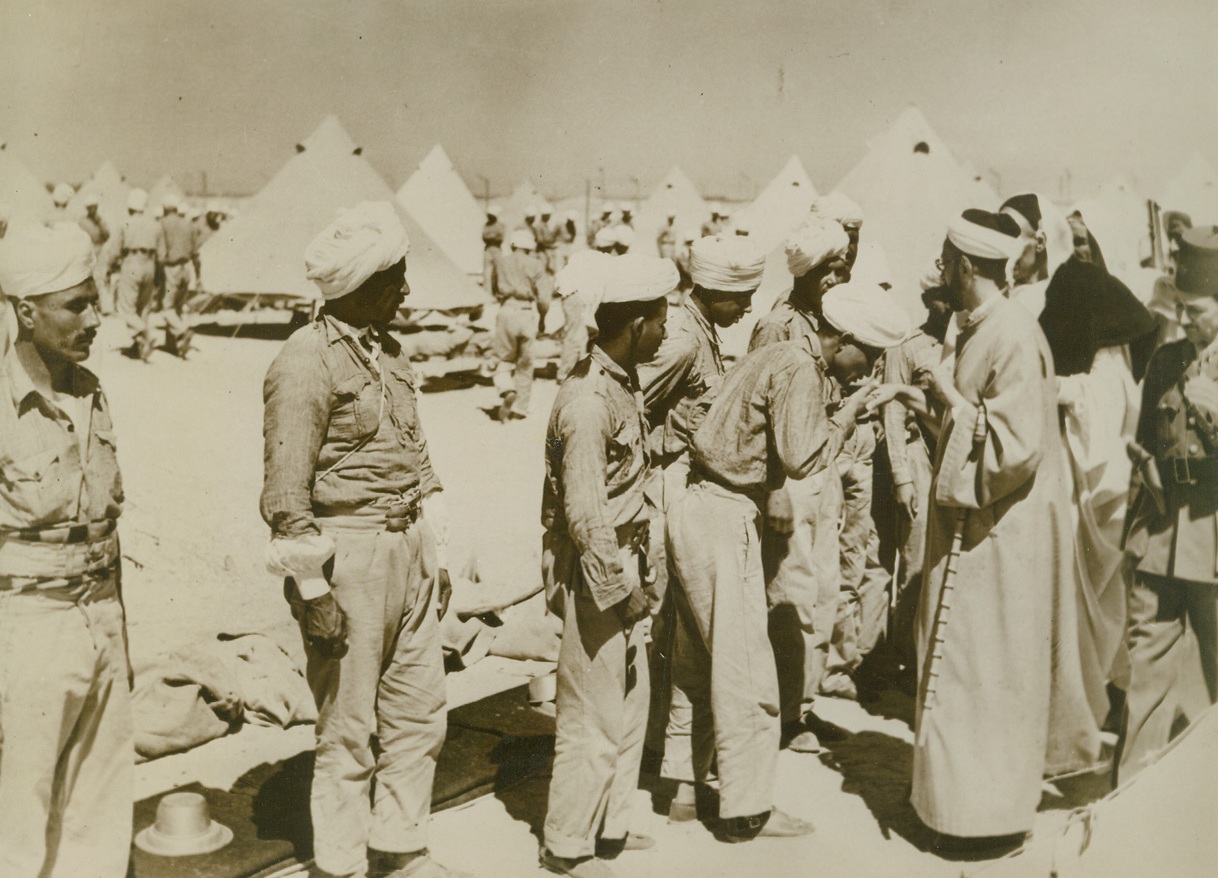
Free Libyans and Leader, 12/5/1940 Egypt – Members of the Senussi – a high religious order – who escaped from Libya, kiss the hand of their leader, Sayed Idris, after arrival in Egypt, where they will join the fight to overthrow Italian control of Libya. Credit line (ACME);
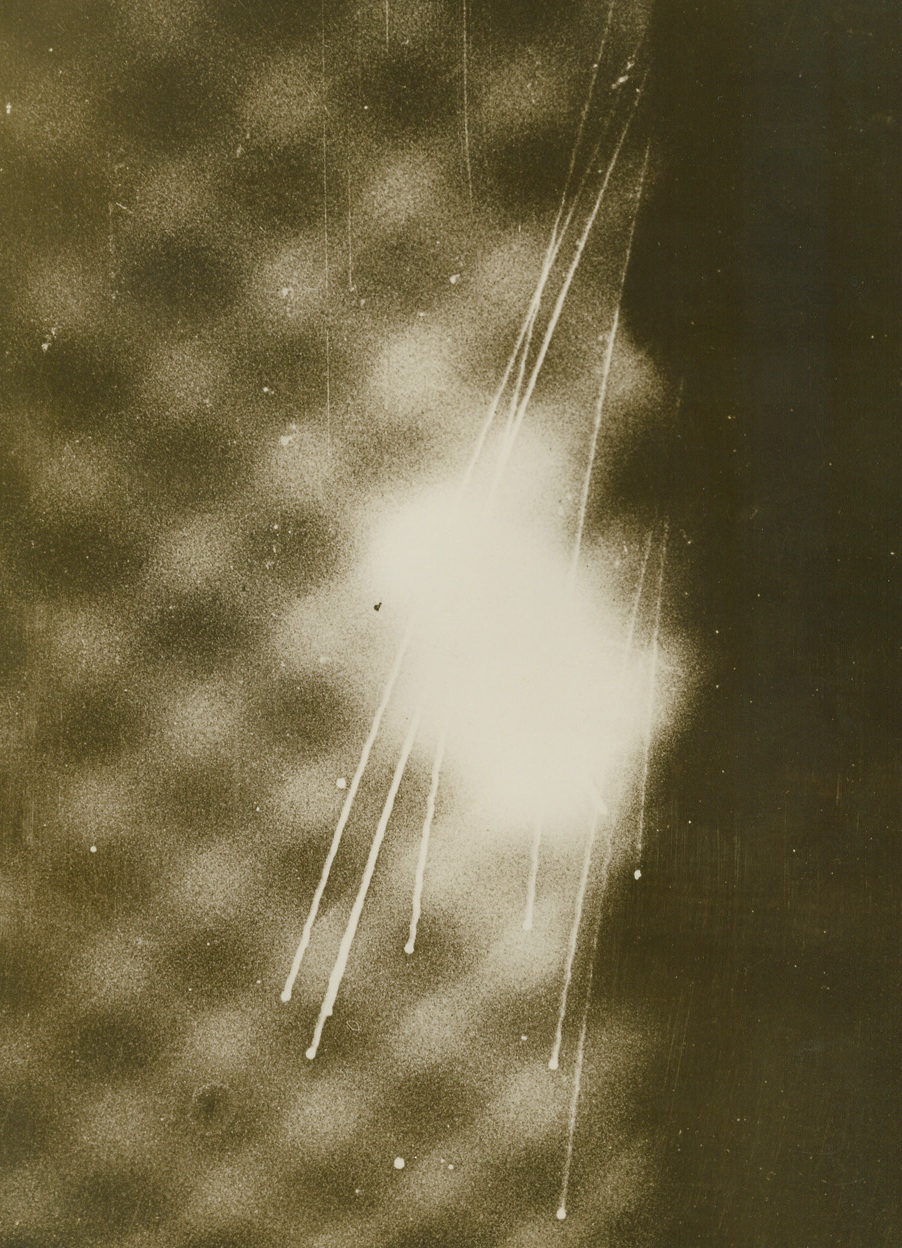
London’s Spectacular Night, 12/5/1940 London - One of the most unusual pictures made of London’s night-time battle against invading German bombers, this photo shows England’s defense against a new menace - parachute flares to offset moonless nights and the blackout. Flares are seen in the center, with tracer bullets fired by anti-aircraft units in an attempt to put them out cutting streaks of brilliant light through the already-bright glare above the city. Credit: ACME;
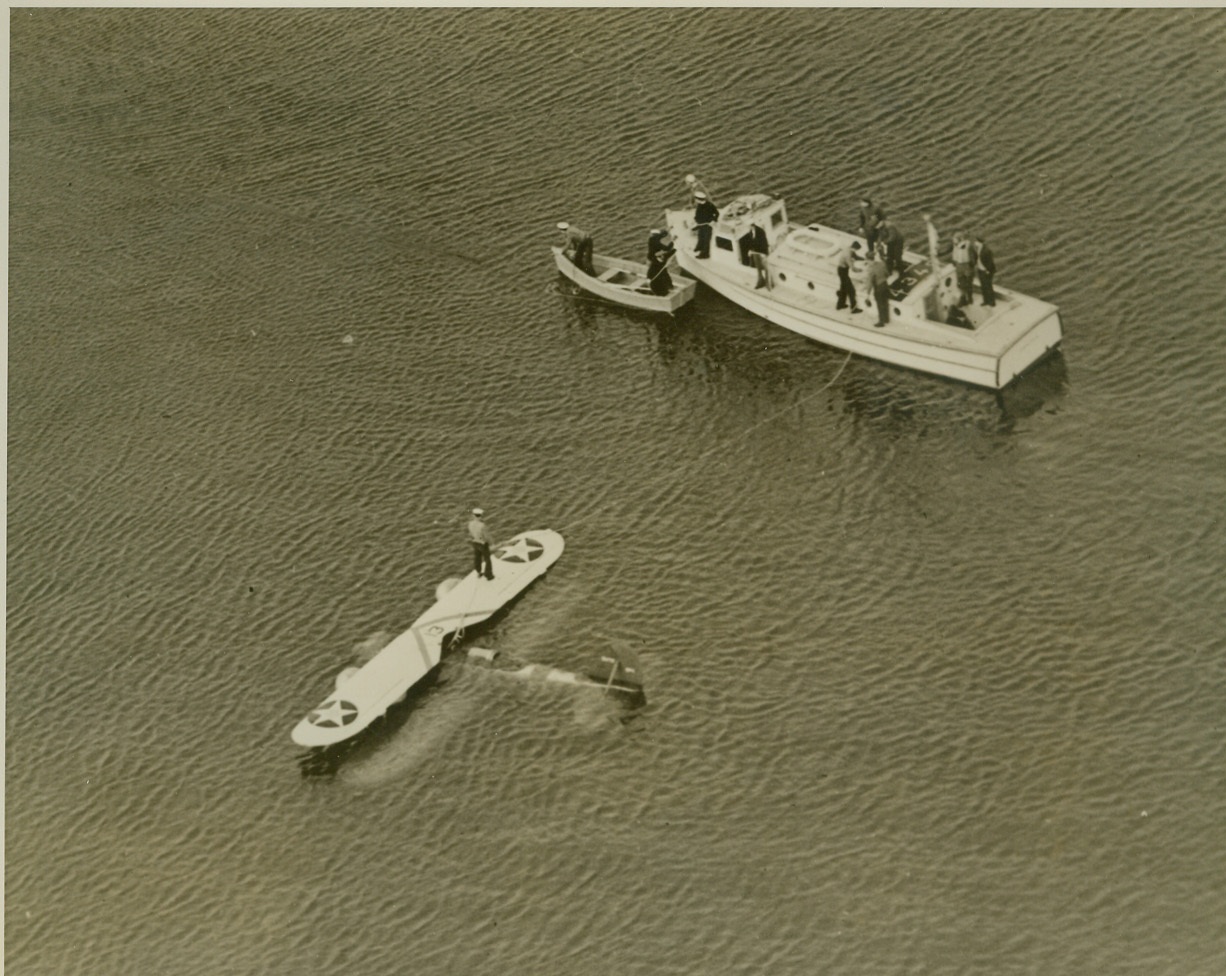
Navy Flier Sits Down Land Plane in Bay, 12/10/1940 New York—About to land his Grumman training plane at Floyd Bennett Field, Ensign Robert Winston discovered that a wheel was locked and could not be released. After dropping a note to field officials explaining his predicament, Winston sat the plane down on the waters of Jamaica Bay between two amphibians waiting for him, and climbed out with his companion, E.J. Marrone, Assistant Machinist’s Mate, nothing wet but their feet. Winston, a former test pilot, saw wartime service in France and Finland. Photo shows the plane on the bay after the occupants- with life preservers in rear of launch- had been rescued. Credit: ACME;
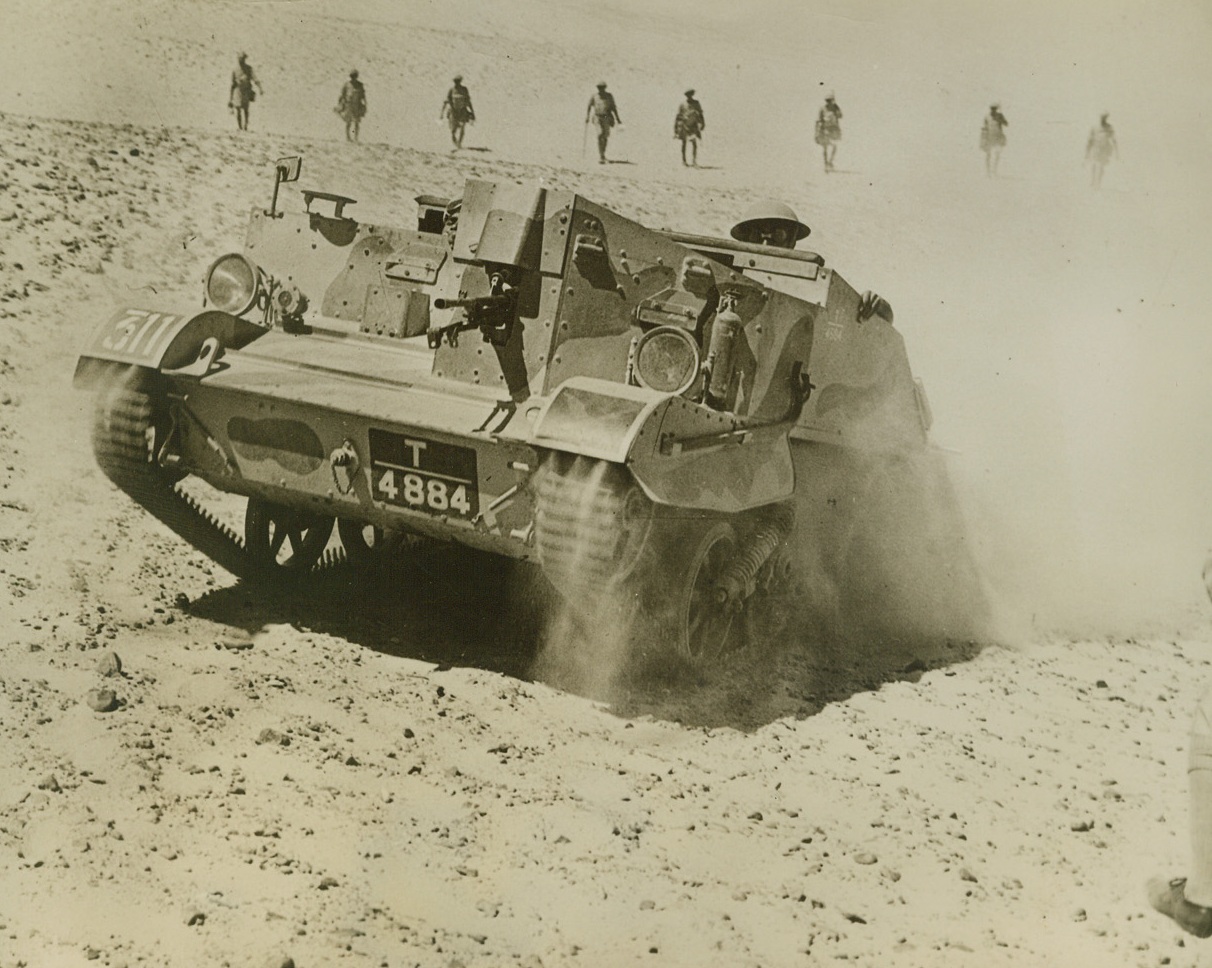
Driving Italians Out of Egypt, 12/12/1940 Desert – With Indian troops, like these shown advancing behind a Bren gun carrier, plays an important part in the fighting, the British forces in Egypt have driven the Italian invaders from practically all of the Egyptian coastline and are forcing them back toward Libya with tremendous losses in men and materials. Credit line (ACME);
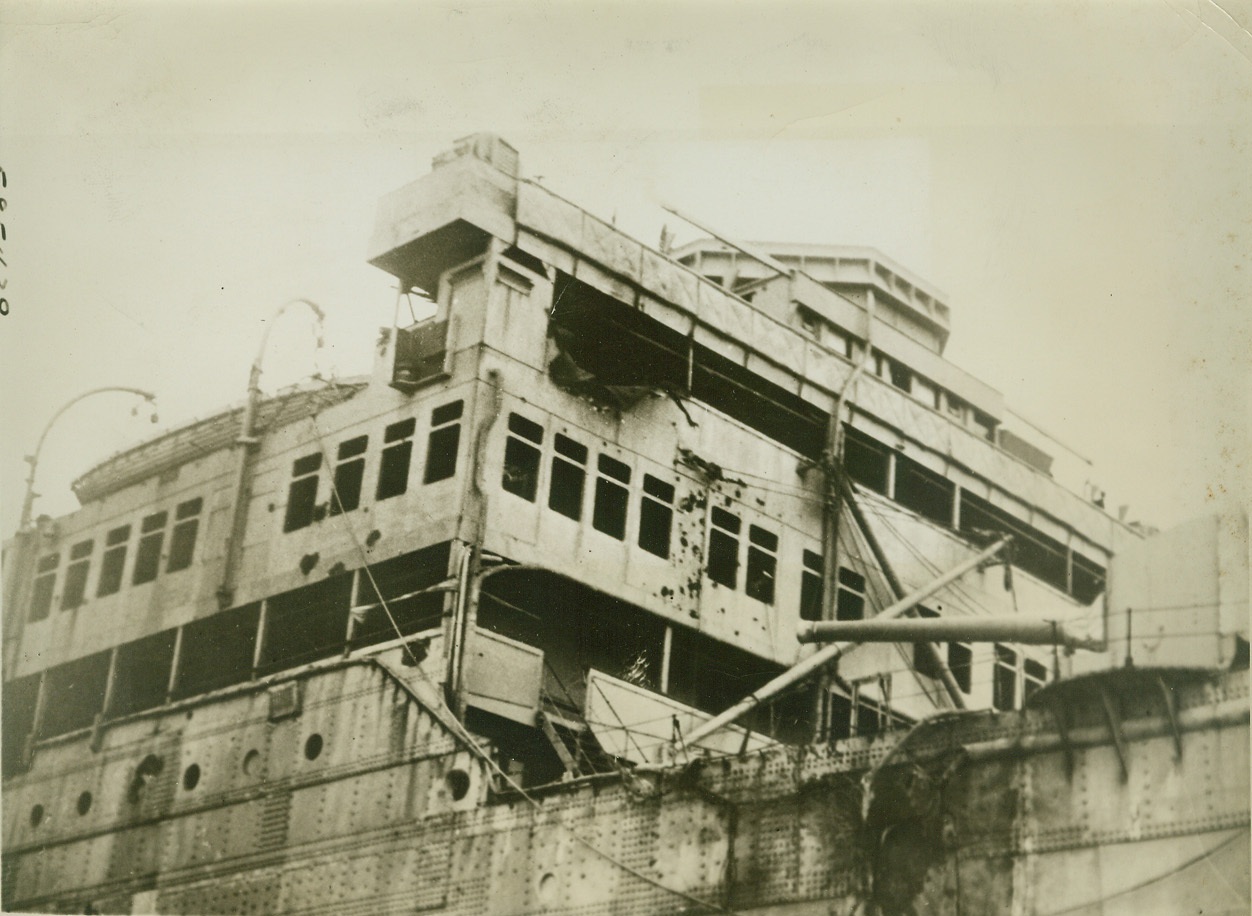
CARNARVON CASTLE SHOWS SCARS OF BATTLE, 12/13/1940 MONTEVIDEO, URUGUAY – One funnel shot away altogether and with her hull and superstructure carrying marks of direct shell hits and flying shrapnel, the British Merchant Cruiser “Carnarvon Castle” is shown as she limped into port after a running battle at sea with a German Raider. At top is shown where a shell struck the promenade deck just below the bridge, while at lower right a gaping wound marks a direct hit by another shell. Shrapnel marks are profuse. Credit: OWI Radiophoto from ACME;
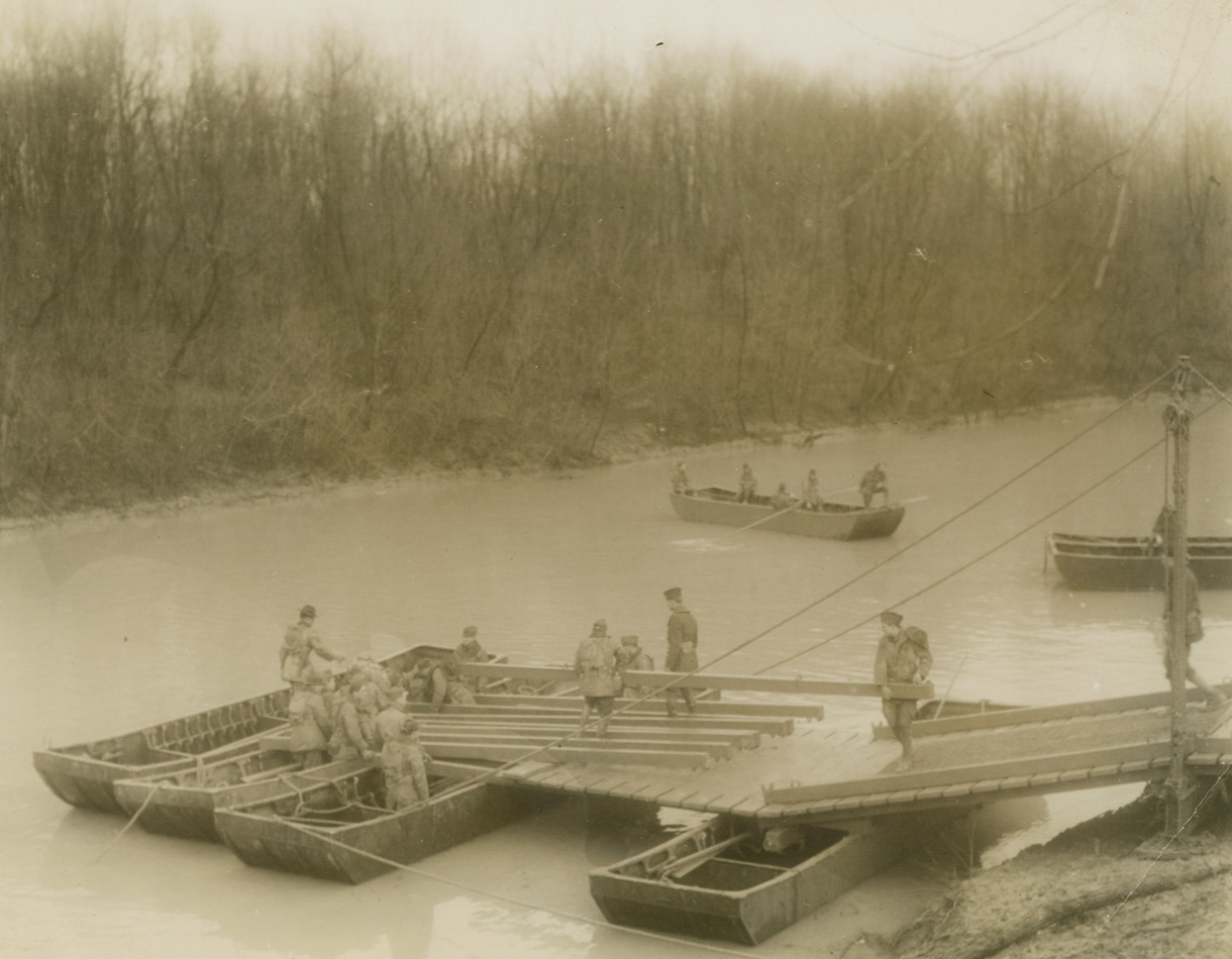
Army’s Armored Division Crosses River, 12/13/1940 Fort Knox, KY—Despite rain and mud, engineers of the First Armored Division erect a pontoon bridge during river crossing exercises, December 13. 11-ton tanks and armored cars safely crossed the river on the completed project. Other machines were ferried across on pontoon boats. Credit: ACME.;
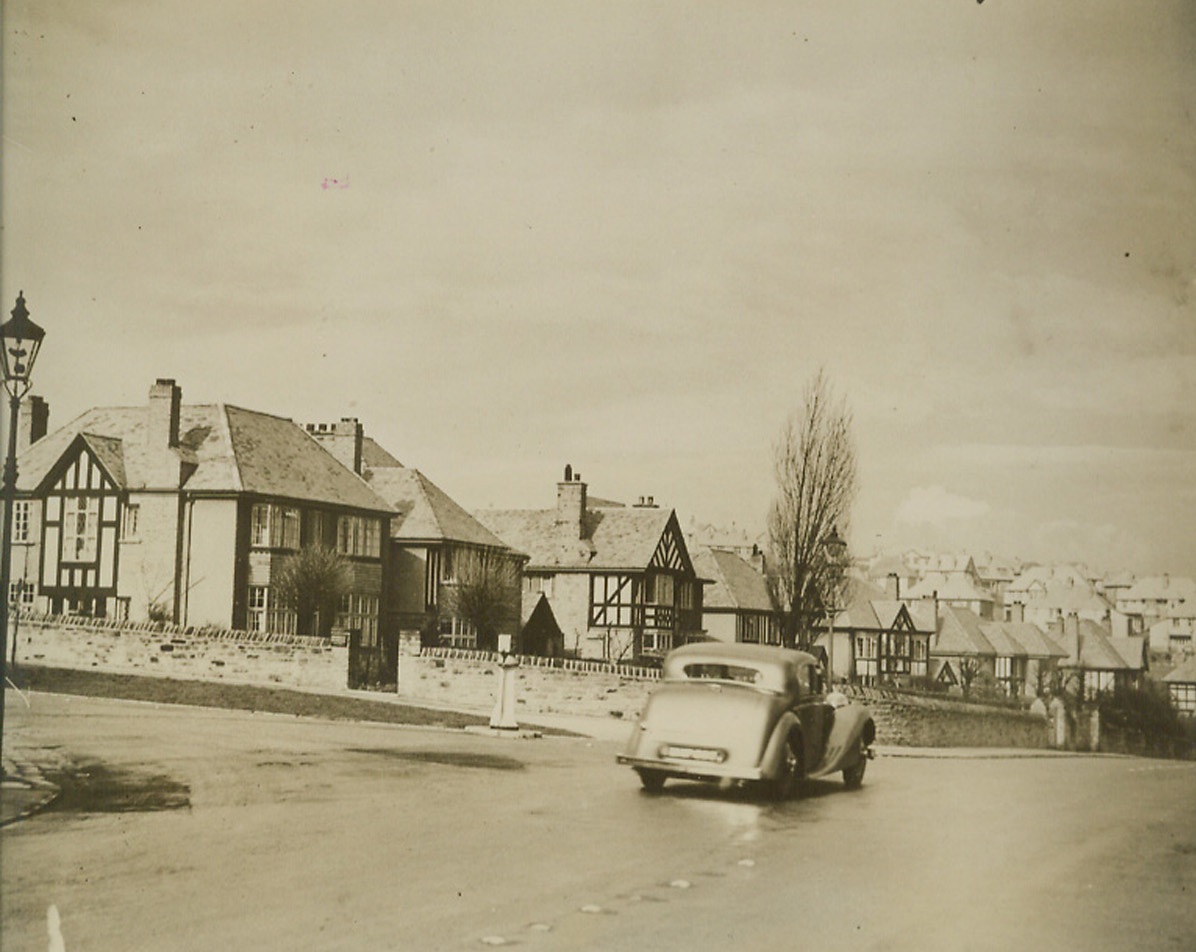
Sheffield Rocked by German Raid, 12/13/1940 Sheffield, England—Modern homes like these in Sheffield were blasted Thursday night, by a German “utter destruction” air raid. Despite its dead and ruins, the famous British steel city continues war manufacturing. Credit: ACME.;
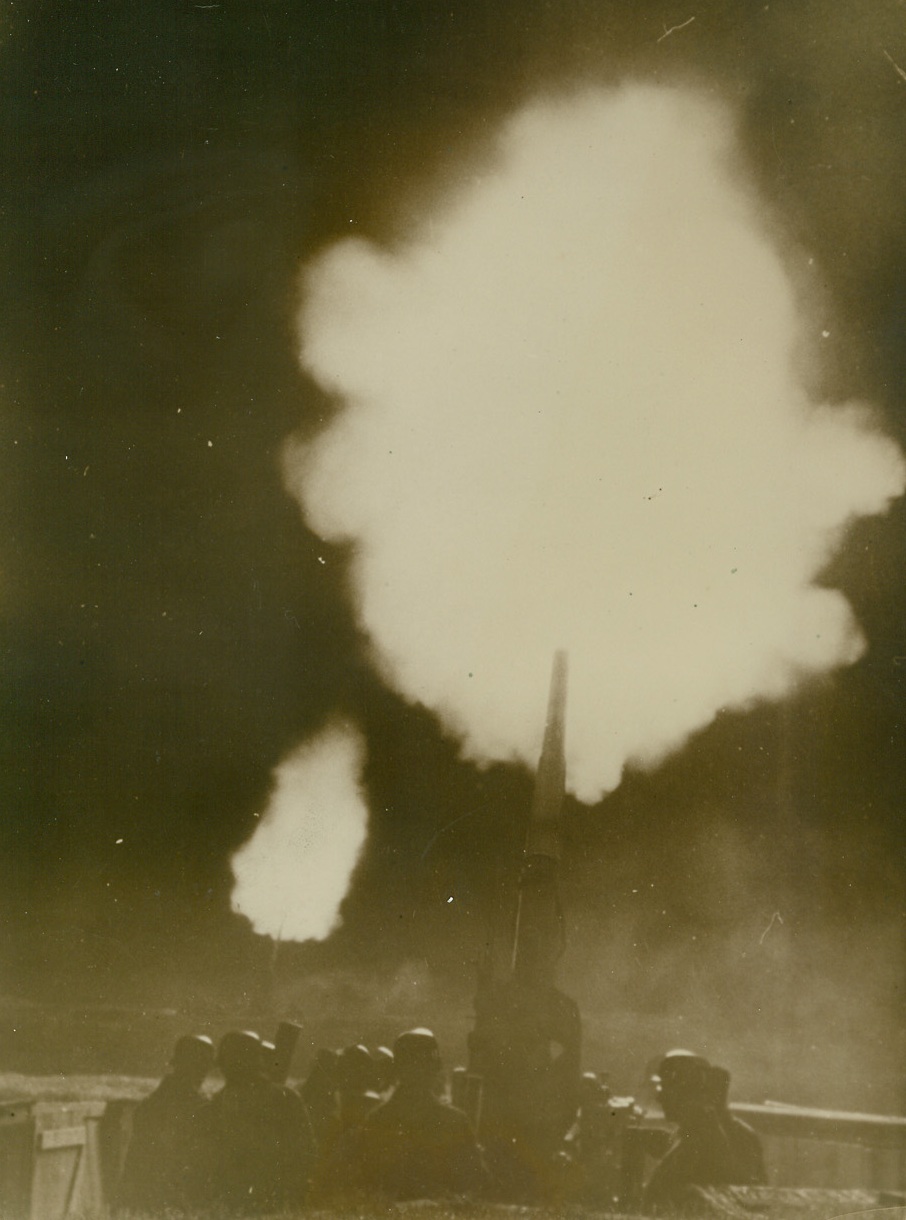
IN DEFENSE OF GERMANY, 12/17/1940 GERMANY—A heavy German “flak,” or anti-aircraft gun, in the foreground and another in the distance belch forth clouds of smoke and flame as they go into action against British planes over Germany. Credit: Acme;
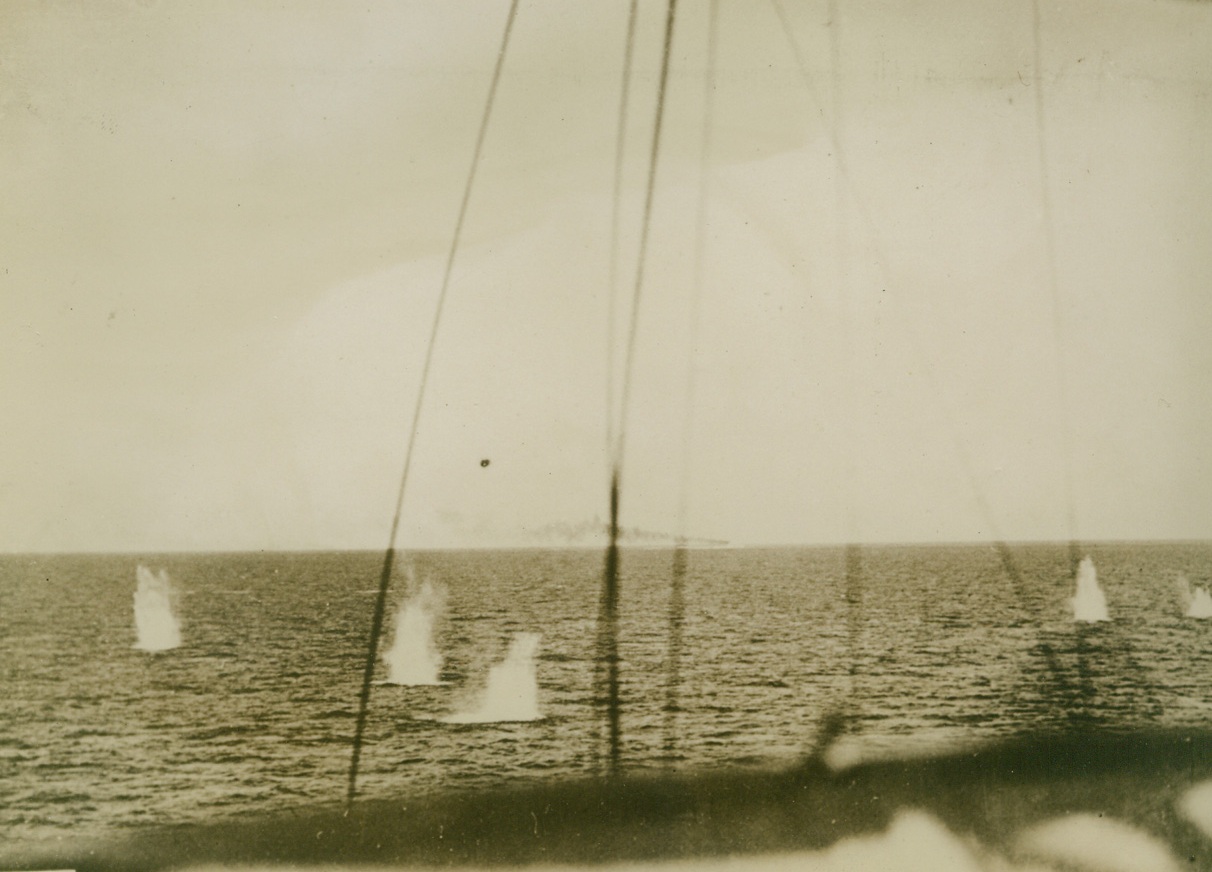
Italian Ship Dodges British Shells, 12/17/1940 SARDINIA – Shells from a British warship drop perilously near an Italian ship during a naval engagement off the south coast of Sardinia. Credit Line (Acme);
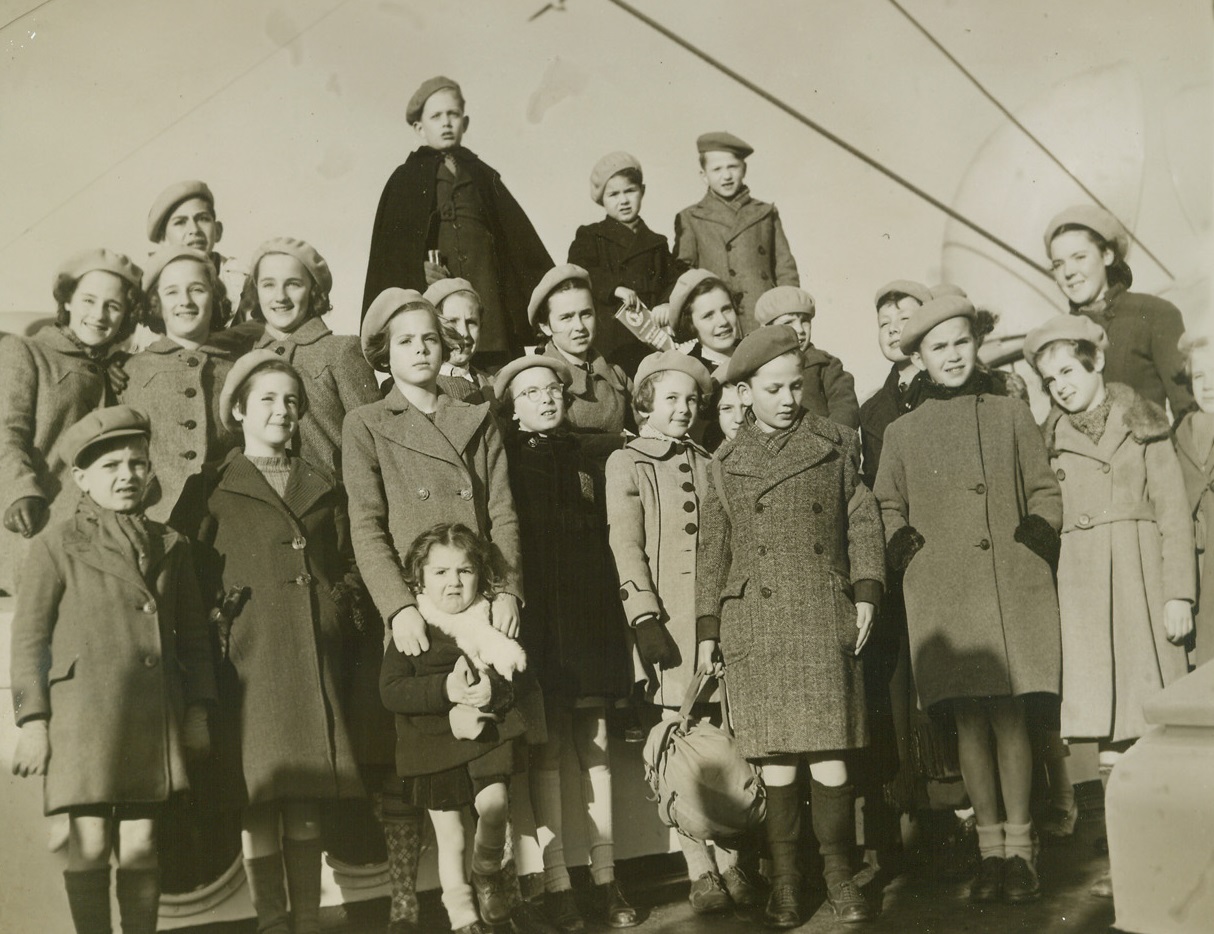
American Committee Brings Over 25 Refugees, 12/23/1940 Jersey City, N.J.—Children of six nationalities were among the 25 arriving on the American export liner Excambion from Lisbon through the efforts of the American Committee for the Care of European Children and the Unitarian Service Committee as the first group to be brought to this country under the Committee’s sponsorship. French, Russian, Austrian, German, Polish, and Czecho-Slovakian make up the group, shown here as they entered New York Harbor aboard the ship. Credit: ACME.;
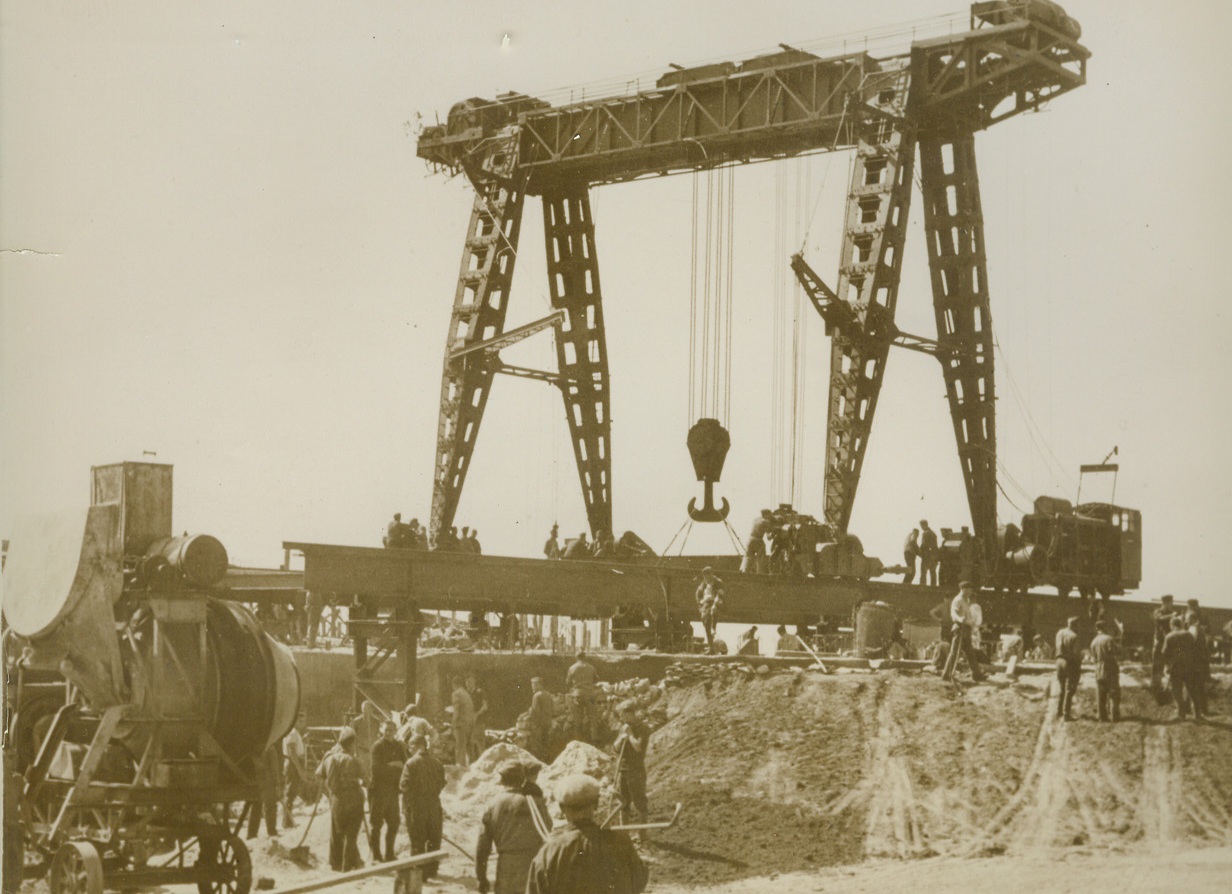
GERMANS BUILDING CHANNEL FORTIFICATIONS, 12/25/1940 A giant crane, hoisting steel girders into position as supports for one of the huge gun emplacements built by the Germans along the Channel coast facing England. Yesterday, (Dec. 24), Nazi officials boasted that their line of fortifications extended for 620 miles along the channel. Credit Line (ACME);
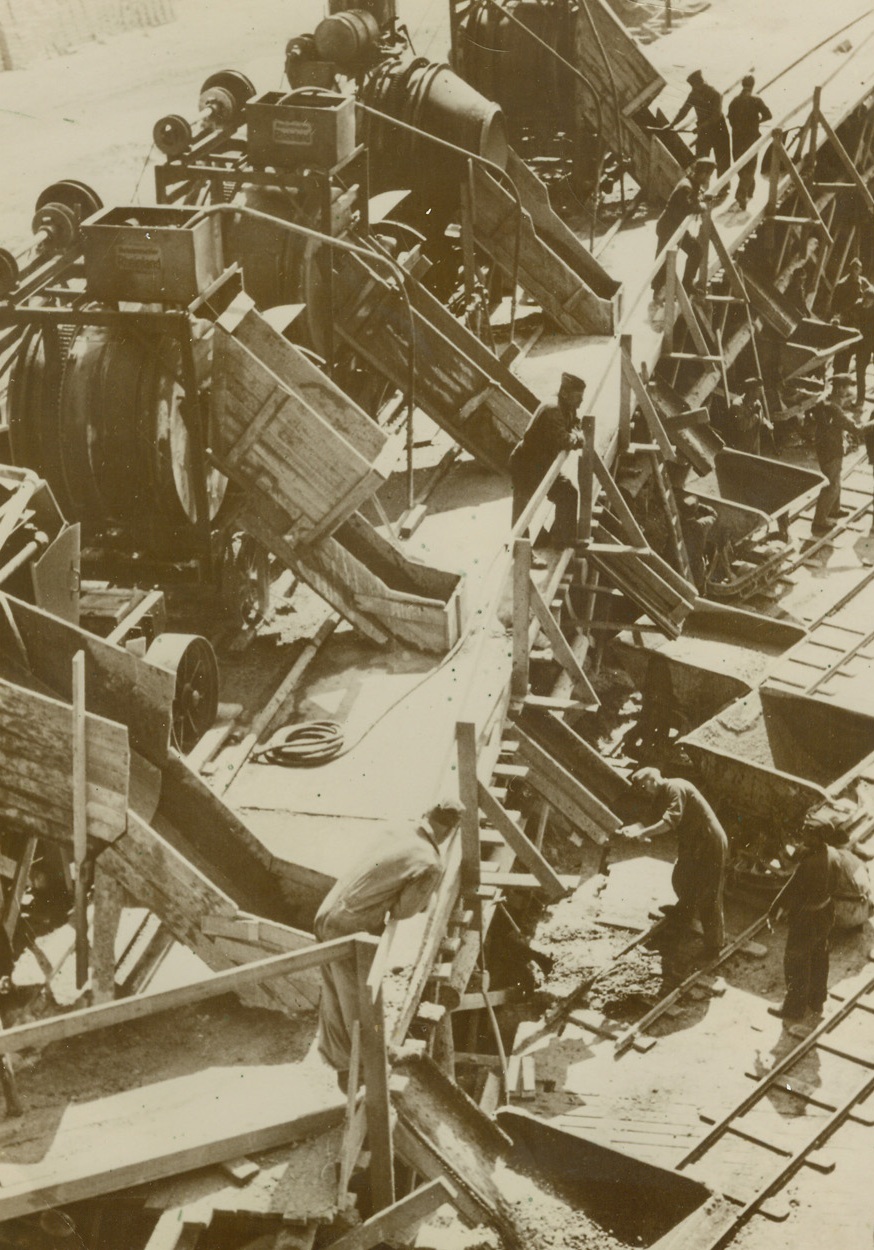
GERMANS BUILDING CHANNEL FORTIFICATIONS, 12/25/1940 where Germans say they have built a line of fortifications extending for 620 miles. Credit Line (ACME);
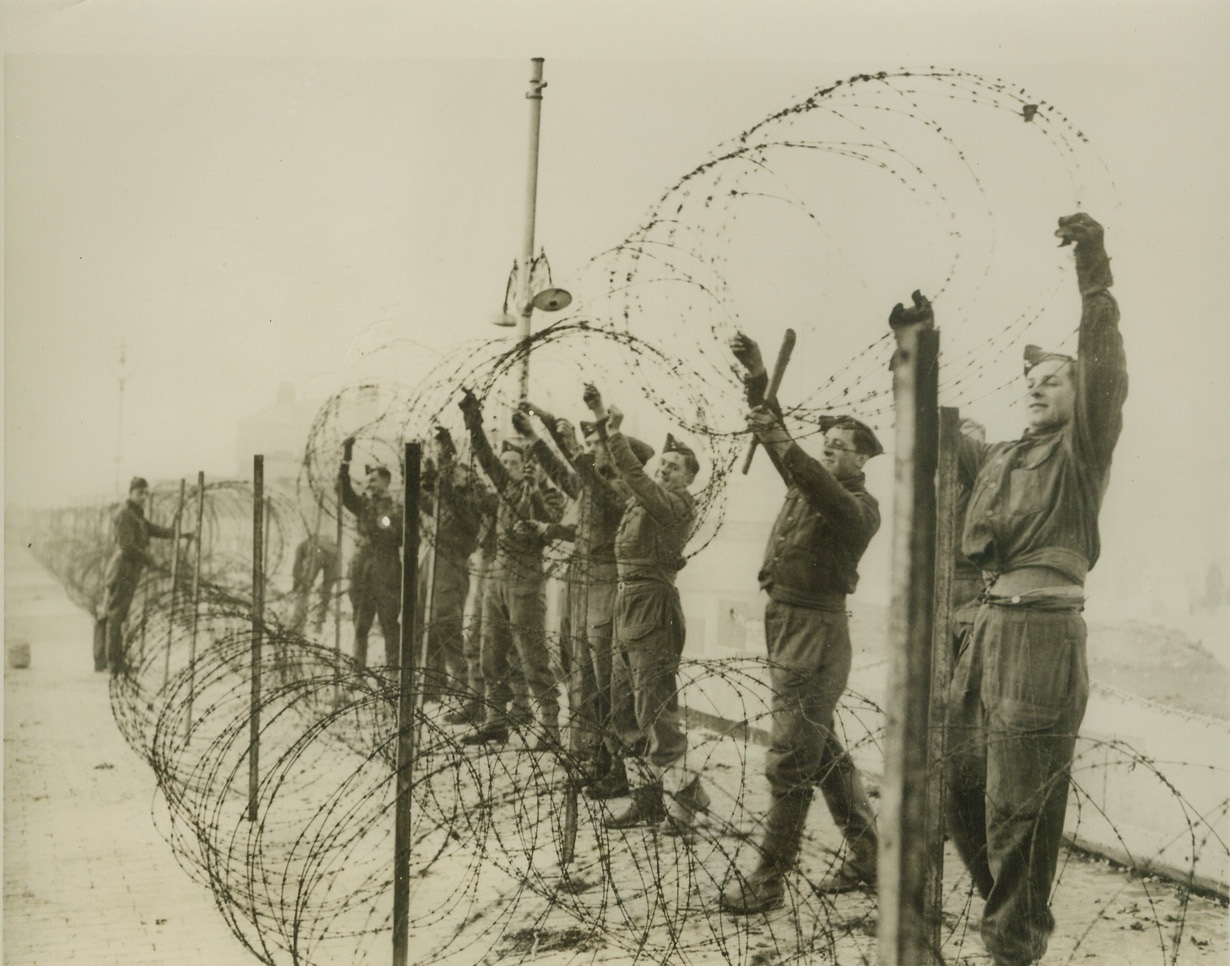
More Anti-Invasion Snares, 12/26/1940 ENGLAND -- As new fears of a German invasion attempt on England, these Tommies strung more barbed wire to strengthen defenses along the English south coast. Credit: (ACME);
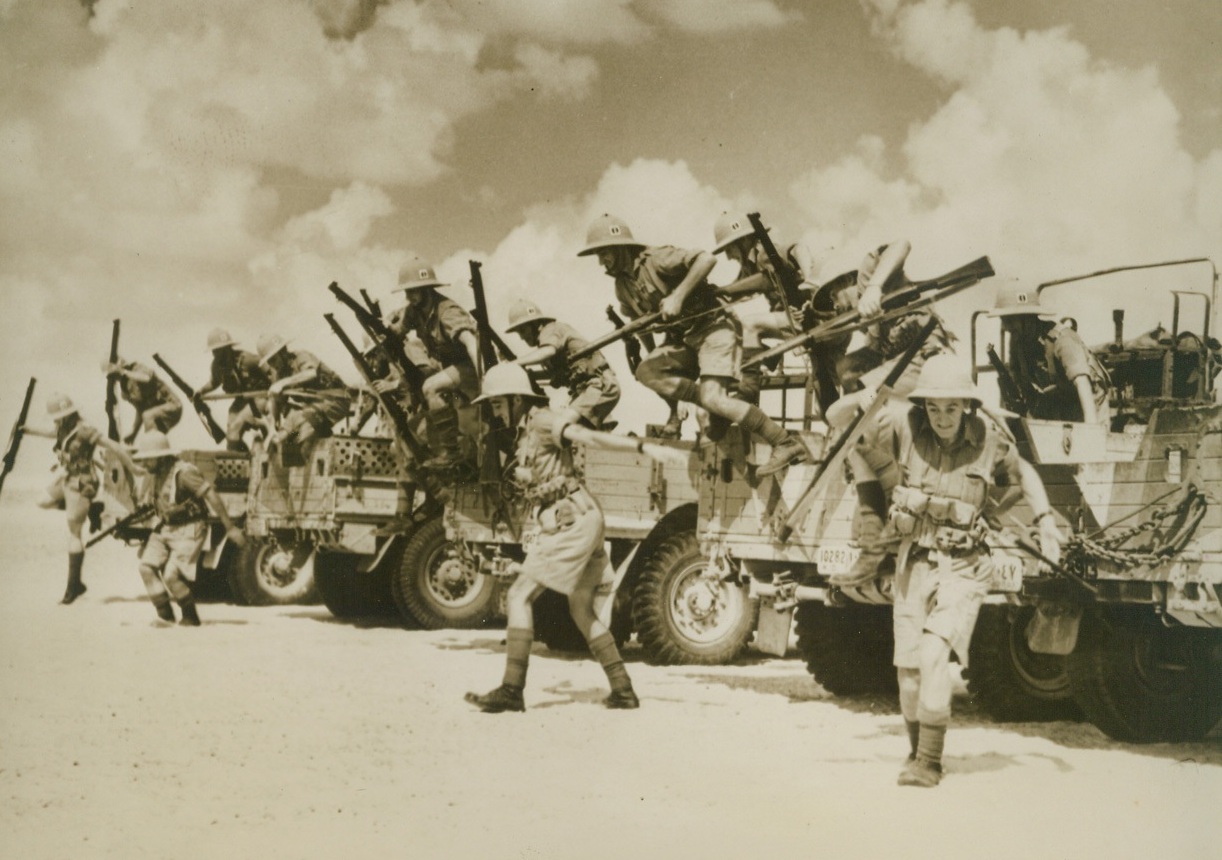
French Syrian Troops Aid British in Desert, 12/26/1940 NORTH AFRICA – Members of the French Colonial Army in Syria, who have joined British Forces in the Desert Campaign, are shown leaving their trucks at a point in the desert. Passed by Censors.;
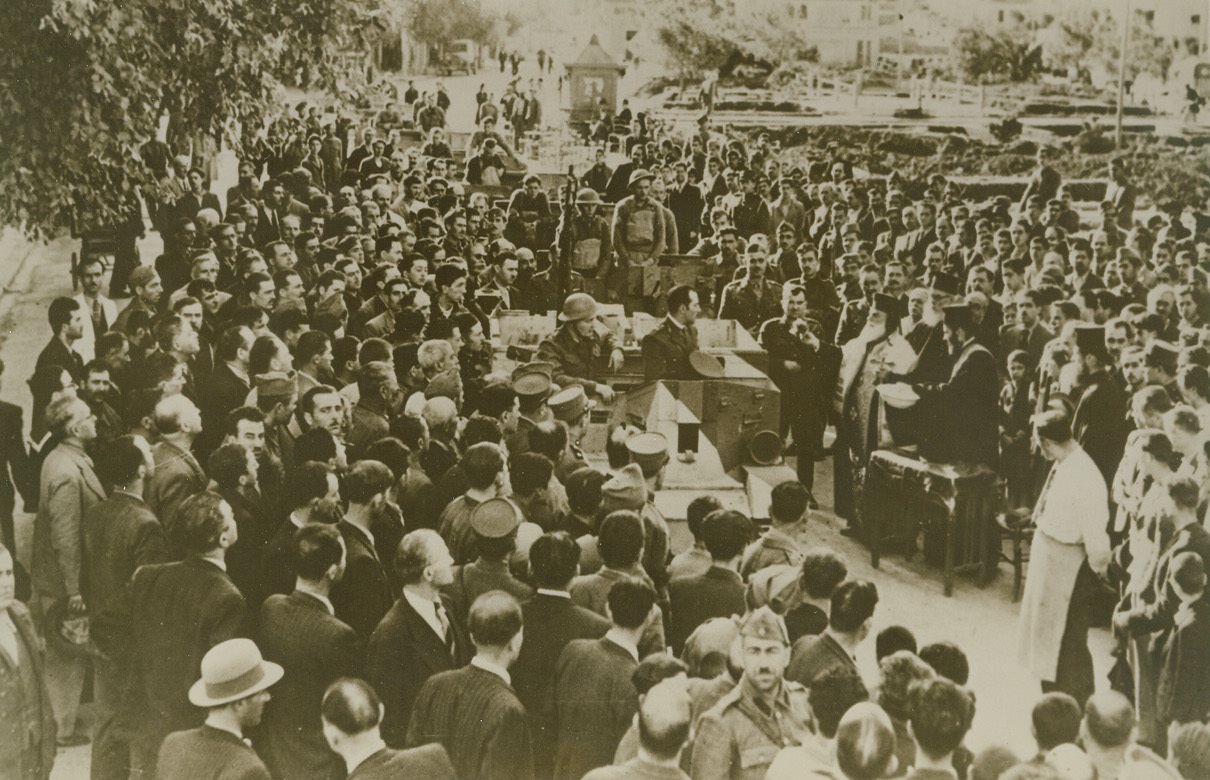
GREEK BISHOP BLESSES BRITISH TANKS, 12/26/1940 KHANIA, CRETE—The Bishop of Khania (Canea), Greek town on the Isle of Crete gave his official blessing to British men and equipment arriving to help his countrymen in their struggle against the Italians, and here he is shown blessing the Bren gun carriers and light tanks in the presence of soldiers and townspeople. Each soldier kissed the cross and received the Episcopal benediction, according to British-censored caption accompanying this photo. Credit: Acme;
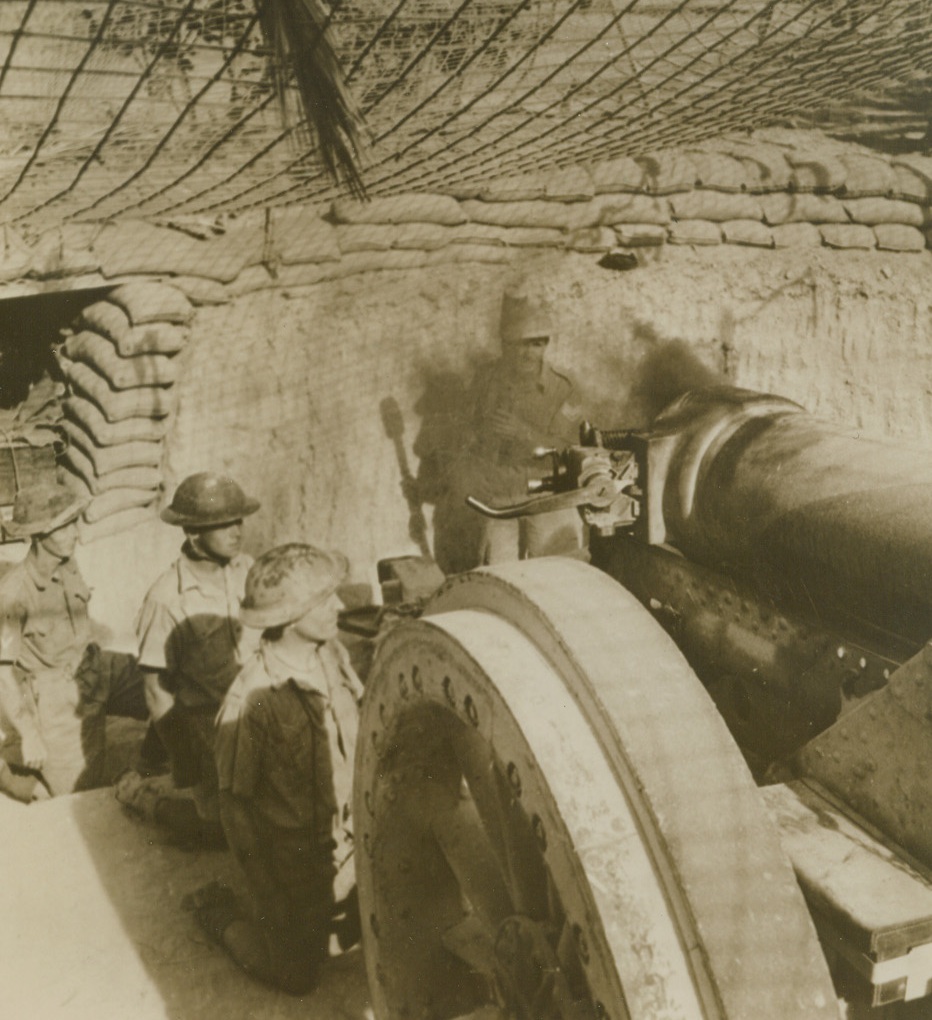
British Guns Boom on the Desert, 12/26/1940 Smoke pours from the breech as a British heavy field gun speaks from its camouflaged emplacement on the Western Desert. Artillery of all types played an important part in recent British successes against Italian forces on the desert. Credit: ACME.;
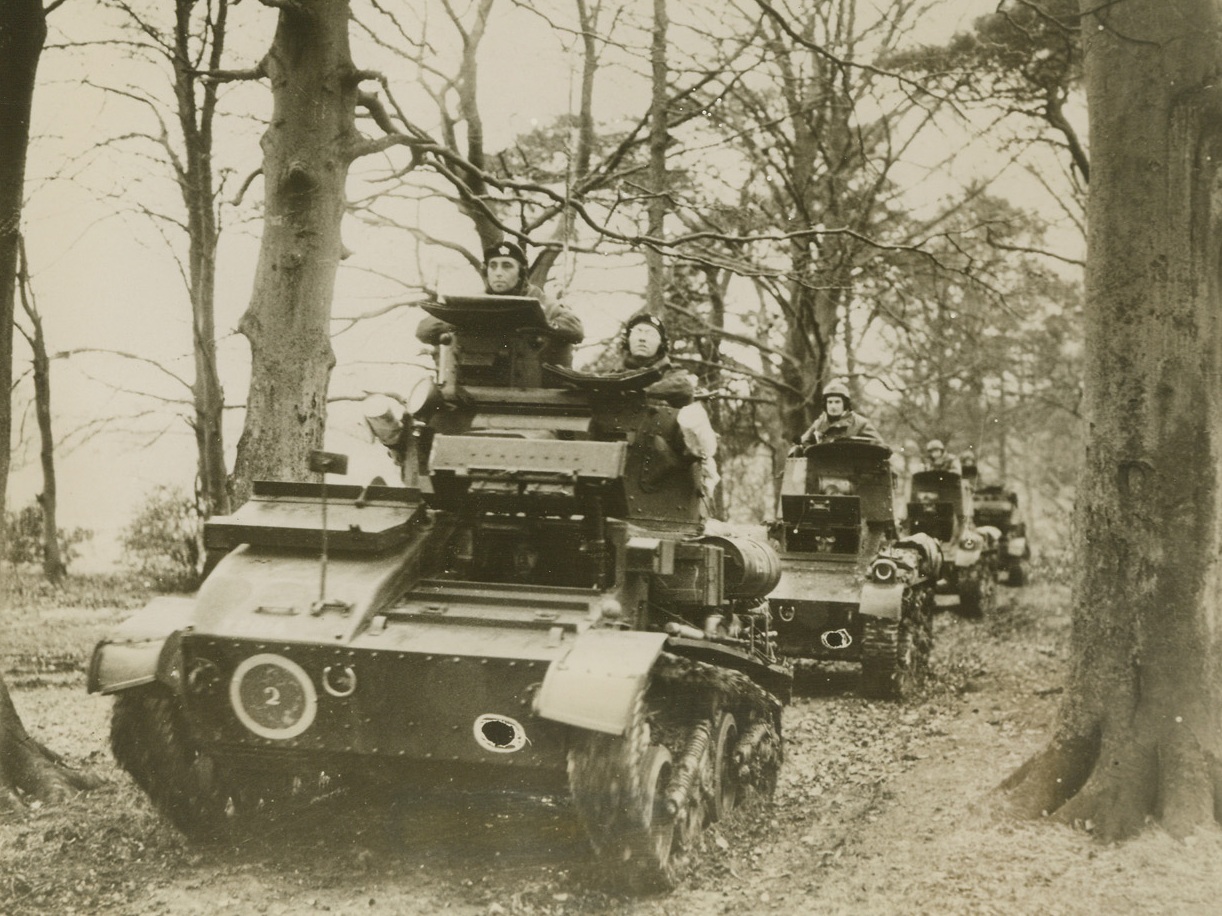
Norse Ready to Help England Thwart Invasion, 12/26/1940 England—As England prepared to meet new threats of invasion, these Norweigan tankmen participated in large-scale maneuvers “somewhere in Britain,” together with British forces. Among the interested spectators was Crown Prince Olaf, of Norway, who recently flew to the United States to spend Christmas with his Princess and family Credit: ACME;
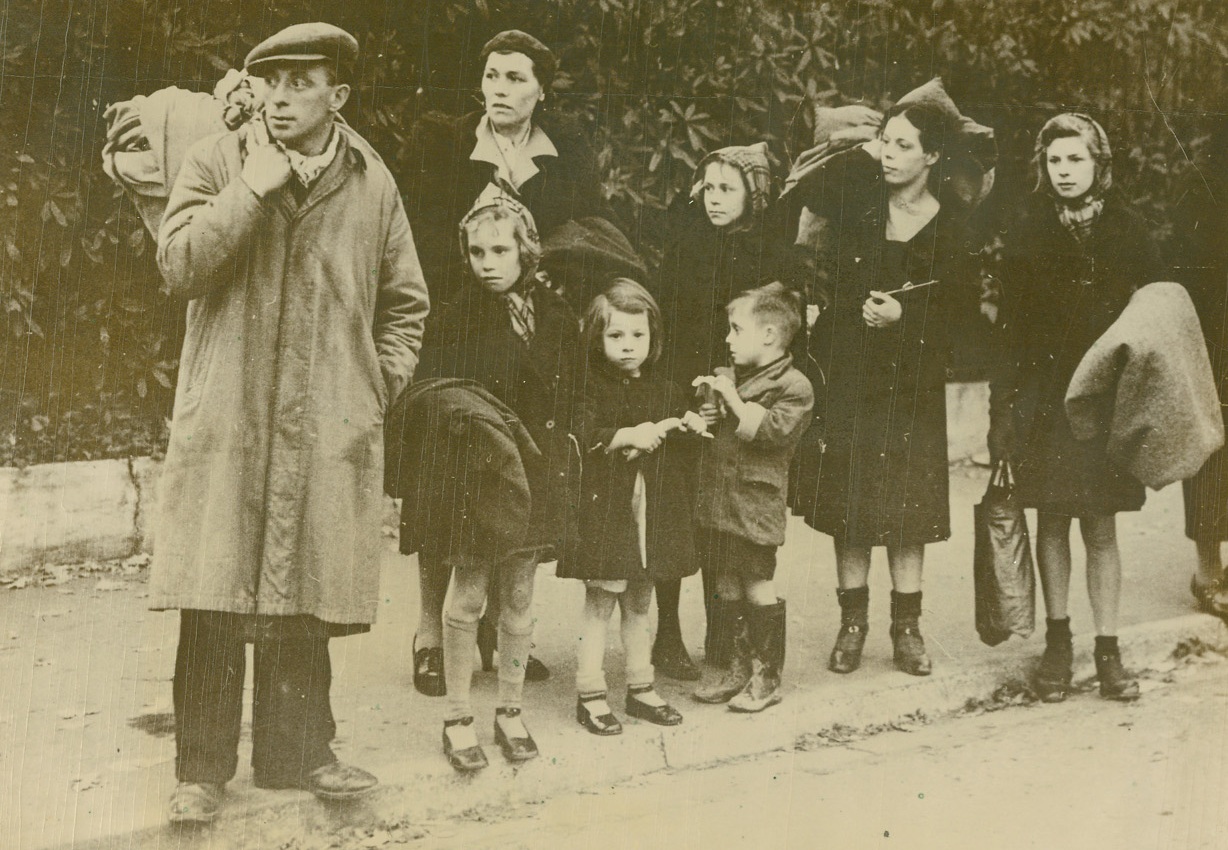
Refugee, English Style, 12/26/1940 Southampton, England – To the long lines of refugees from Hitler-conquered countries are added now English civilians driven from their homes by bombs and forced to seek shelter in other more fortunate towns. These residents of Southampton, their homes destroyed, are waiting on the city limits for a passing car or truck to carry them away to more peaceful areas. Passed by British Censor. Credit: ACME;

Free French Bring Destroyer To British Navy, 12/26/1940 One of the French vessels joining the English Navy under the banner of Free France after the surrender of their homeland was this Destroyer. Here Free French sailors display their flag aboard the Destroyer. Passed by British Censors. Credit: ACME;
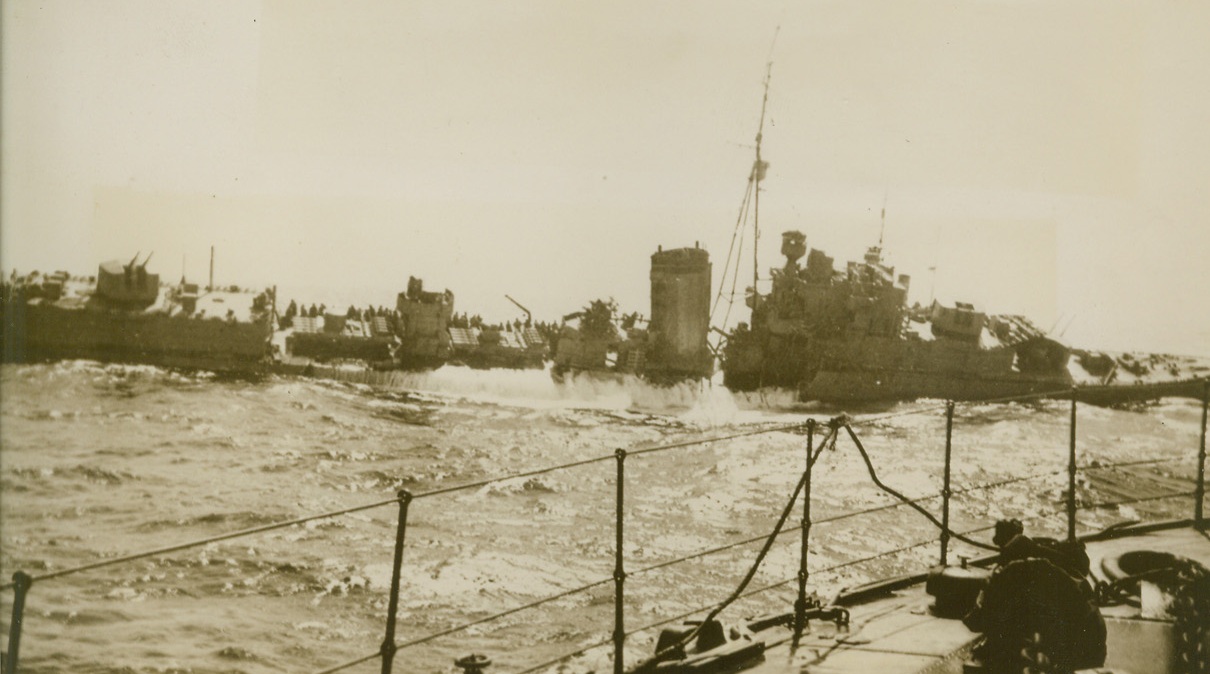
Torpedoed British Destroyer Makes Port, 12/26/1940 England – Her decks awash and listing heavily, the British destroyer flotilla leader H.M.S. Kelly is shown in this remarkable picture after she had been struck by a torpedo from a German motor torpedo boat. Members of her crew can be seen on the listing decks. The Kelly was towed into a British port and refitted, disproving the German claims made in a communiqué last May that she had been sent to the bottom. The torpedoing took place in the North Sea off the coast of Germany. Passed by British censor. Credit: ACME;
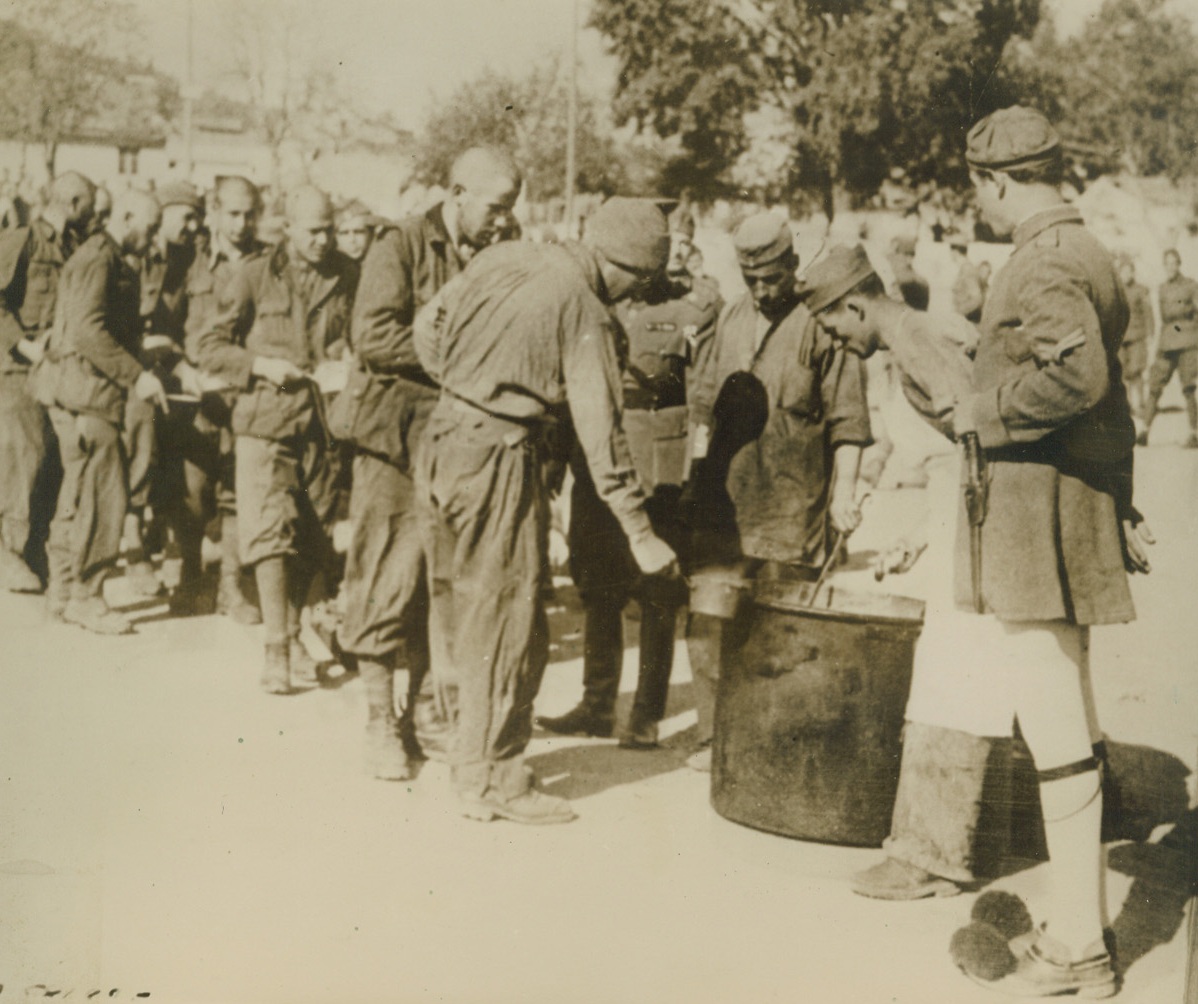
SOUP’S ON FOR ITALIAN PRISONERS, 12/27/1940 Anxiously lined up for food are these Italian prisoners—many with heads shaved—shown at an undisclosed Greek internment camp. Thousands of Mussolini’s soldiers have a similar existence. Credit: Acme;

MAKING THE ENEMY AT HOME, 12/27/1940 THE WESTERN DESERT—An Italian airman shot down in a battle over Mersa Matruh Oct. 31 receives a bandage for his wound and a cigarette for his nerves from attendants at an R.A.F. desert medical station. According to British-censored caption accompanying this photo twelve Italian planes were shot down in the engagement, eight of them in flames, and this airman was the only survivor of the 35 flying the planes. Credit: Acme;
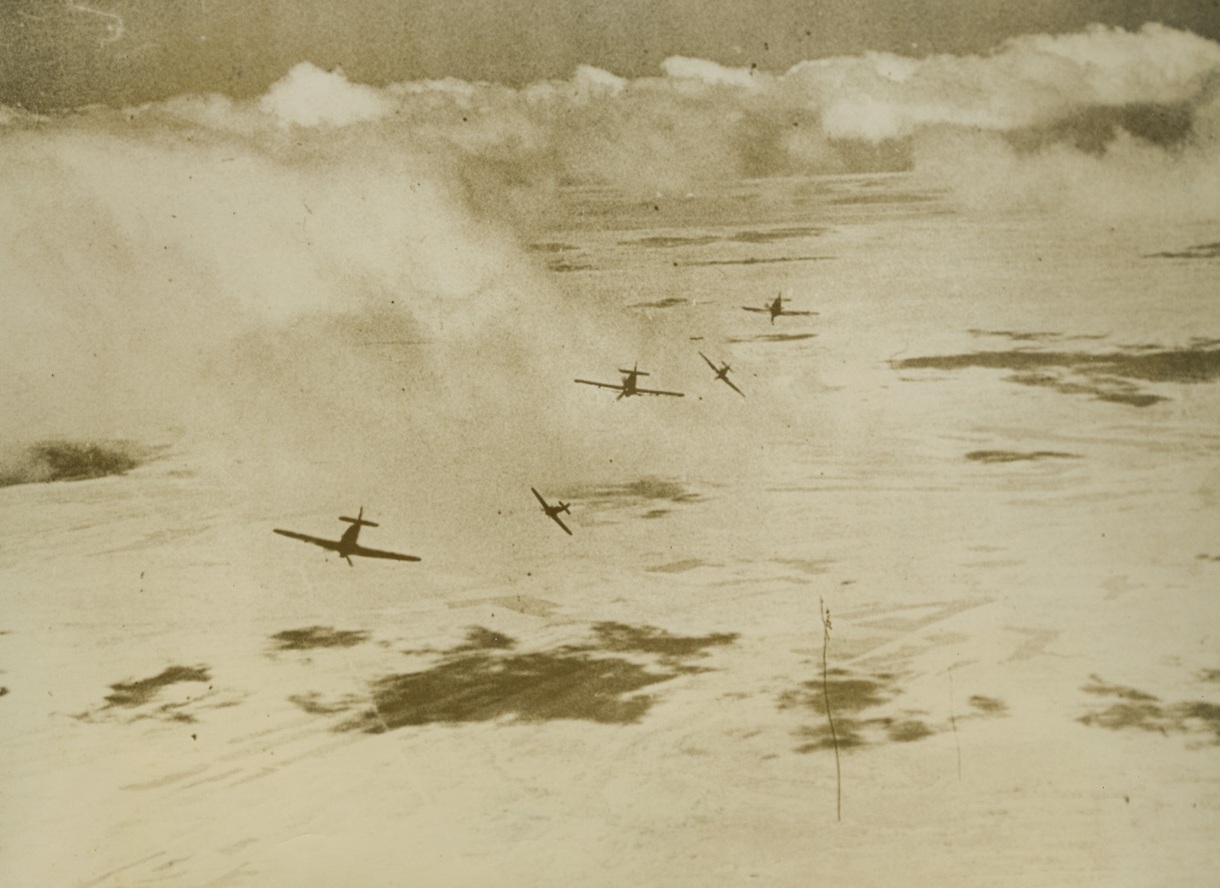
Hurricanes in the Middle East, 12/27/1940 The Middle East – A flight of hurricane fighters on patrol on the Middle East front breaks to attack enemy aircraft reported to them by radio, according to British-censored caption with this striking photo. Credit line (ACME);
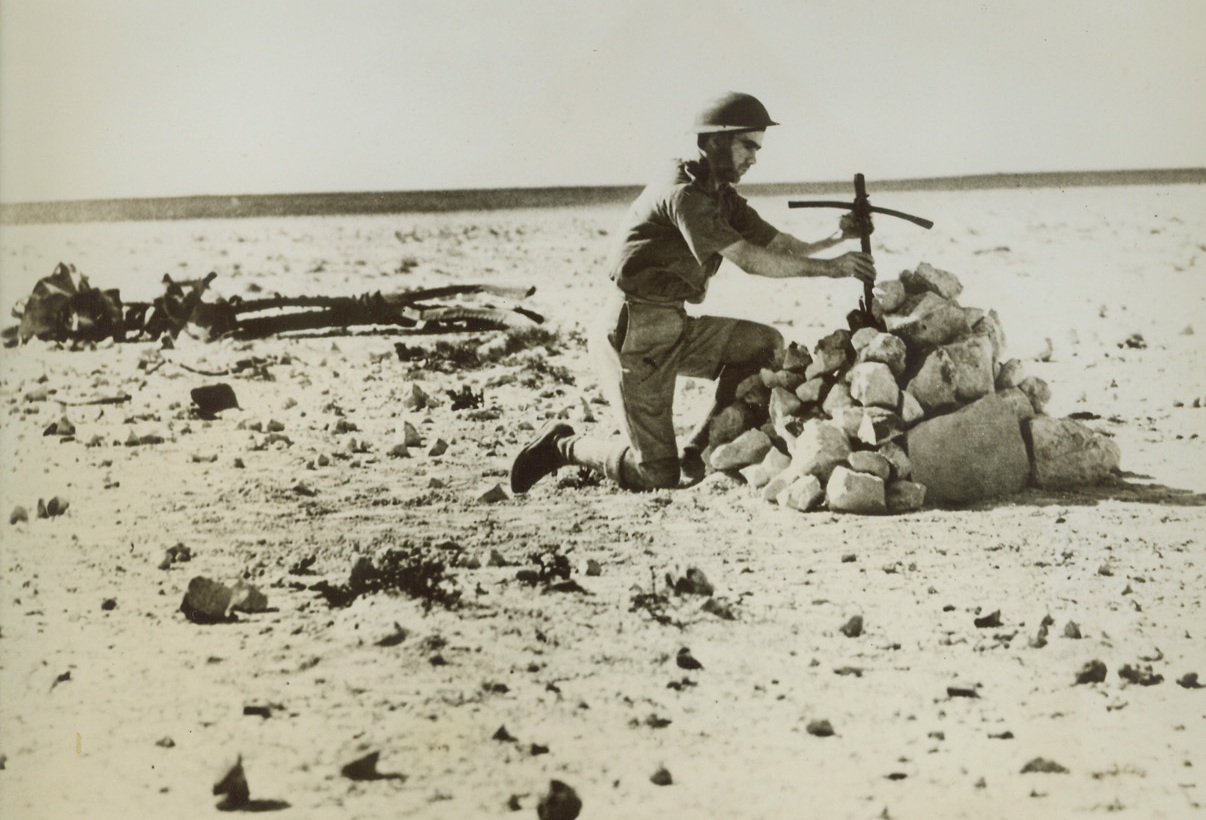
A Last Courtesy, 12/27/1940 Mersa Matruh, Egypt – An R.A.F. airman places a cross made from the wreckage of their S.79 plane over the grave of five Italian airmen shot down in battle over the desert Oct. 31. Eight Italian aircraft were shot down in flames, four were seriously damaged, and only one of the 35 airmen flying the twelve planes escaped death. Credit line (ACME);
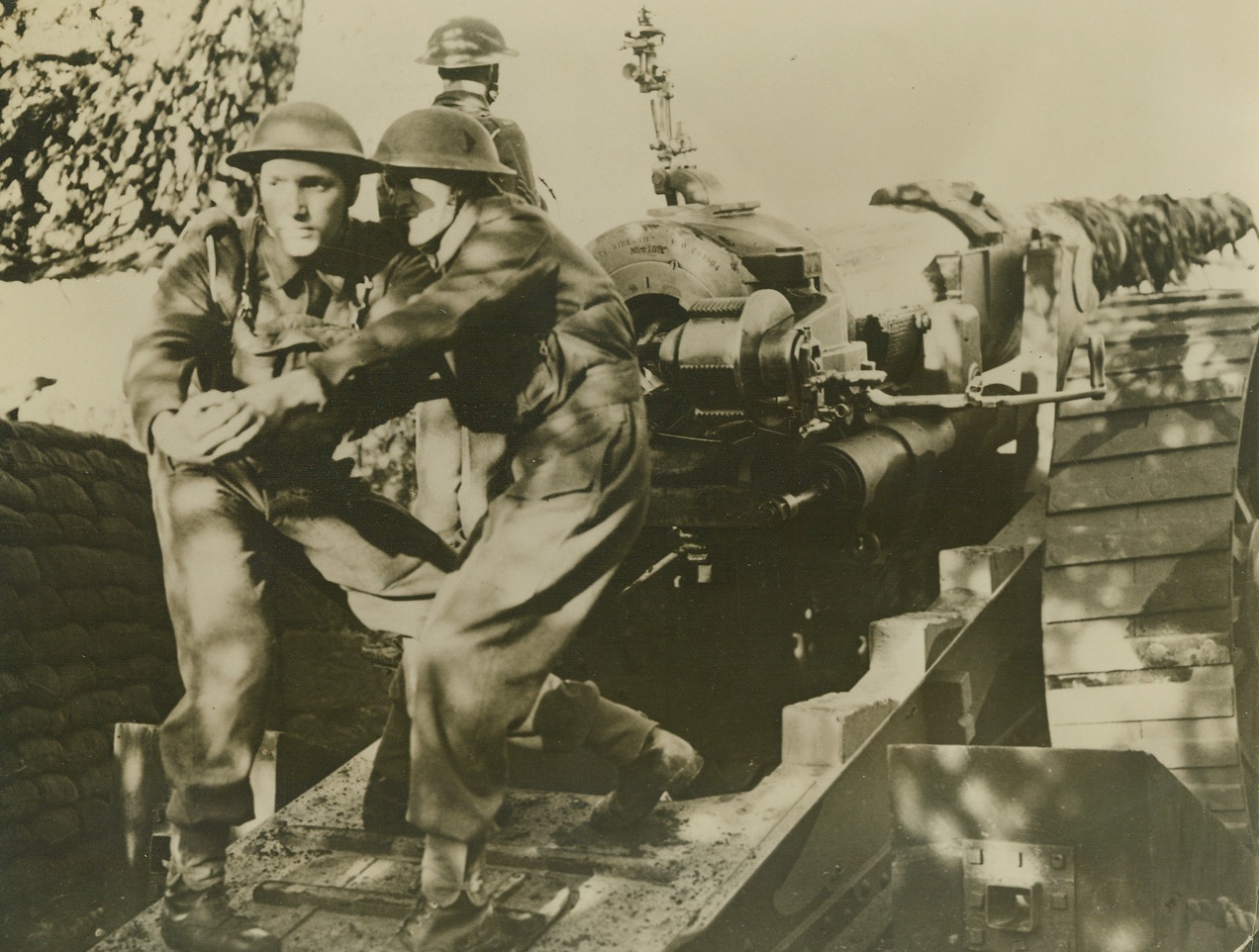
In Defense of the Scottish Coast, 12/27/1940 Scotland -- A shell is rammed into the breech of a six-inch gun during gunnery practice along the east coast of Scotland. Credit: ACME;
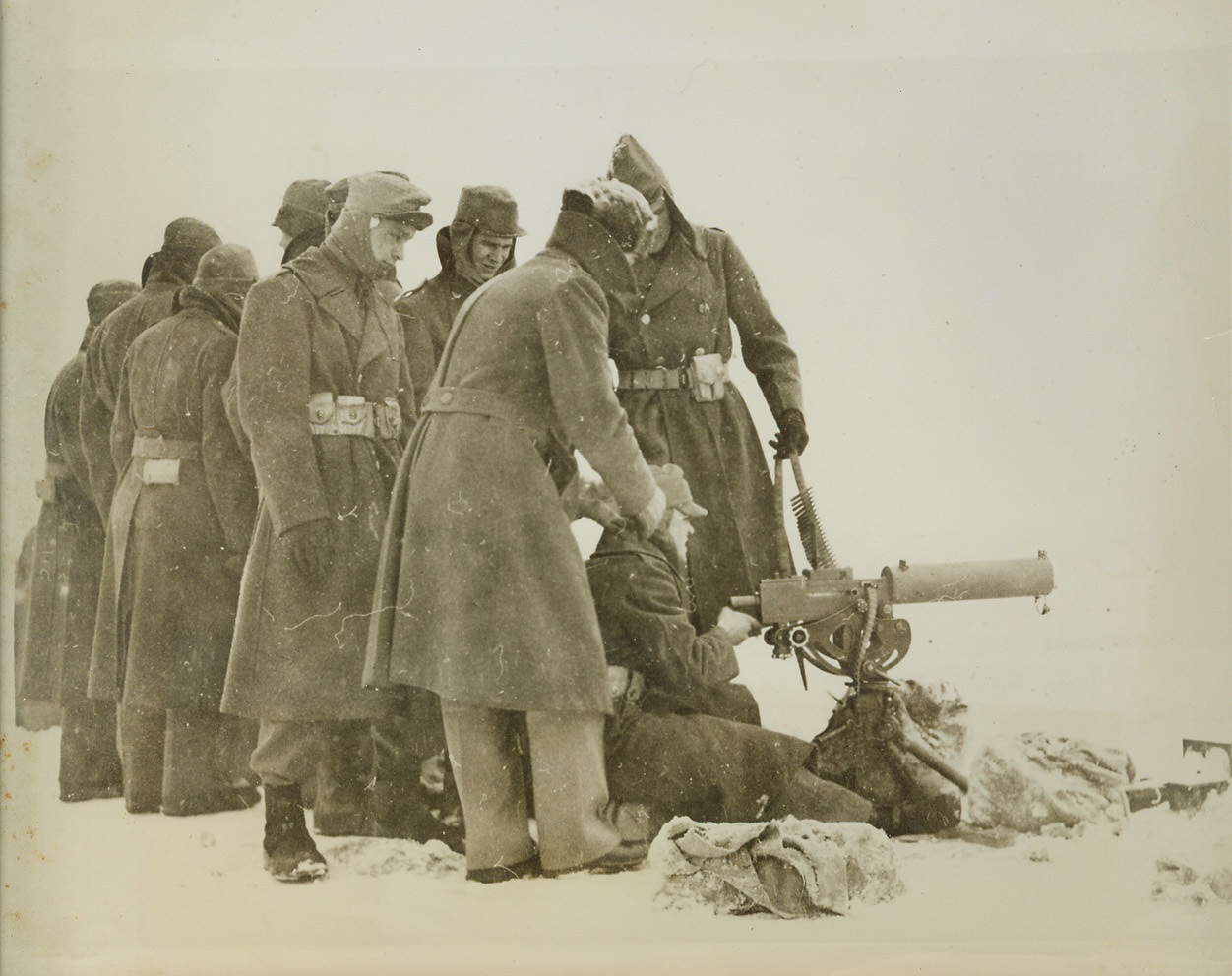
U.S. Army Trains for Winter Fighting, 12/28/1940 PLATTSBURG BARRACKS, N.Y. – Army officials haven’t overlooked the phase of winter fighting. At Plattsburg Barracks, N.Y., a group of recruits look on as another fires a machine gun in subzero temperature along the shore of Lake Champlain. The instructor (directly behind the gunner) is Lieut. Albert R. Cupello, of the 26th Infantry. Credit: (ACME);
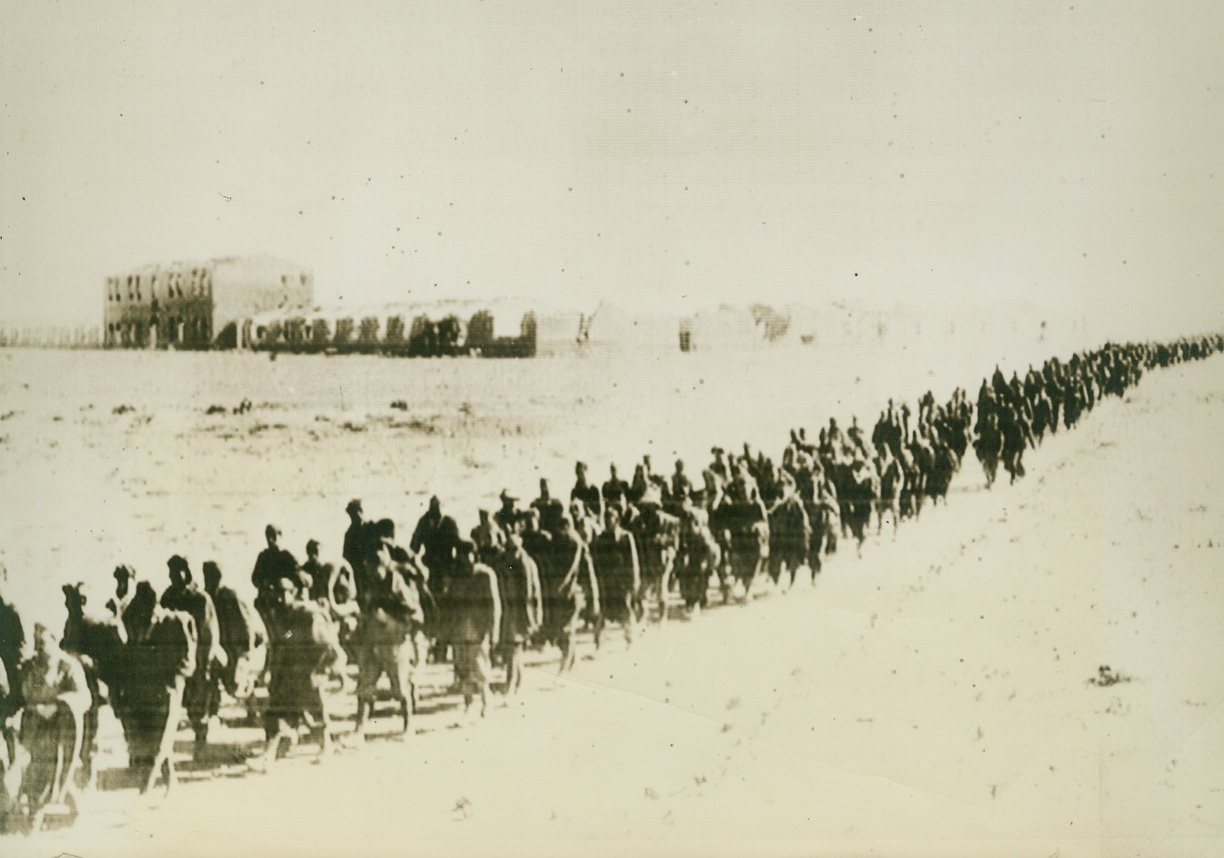
Captured Italians Leave Sidi Barrani, 12/29/1940 SIDI BARRANI, EGYPT – The ruins of their base in the background, some of the more than 10,000 Italians captured by the British at Sidi Barrini march away to spend the remainder of the war in a desert prison camp. Farthest point of Italian penetration into Egypt, the base was retaken by the British Dec. 11 after a heavy bombardment from land, air, and sea.Credit: (ACME CABLEPHOTO);

German Bombs Fire British Oil Tanks, 12/29/1940 ENGLAND – British oil storage tanks at Pembroke Dock burning, after bombing by German planes, according to Berlin-approved caption.;
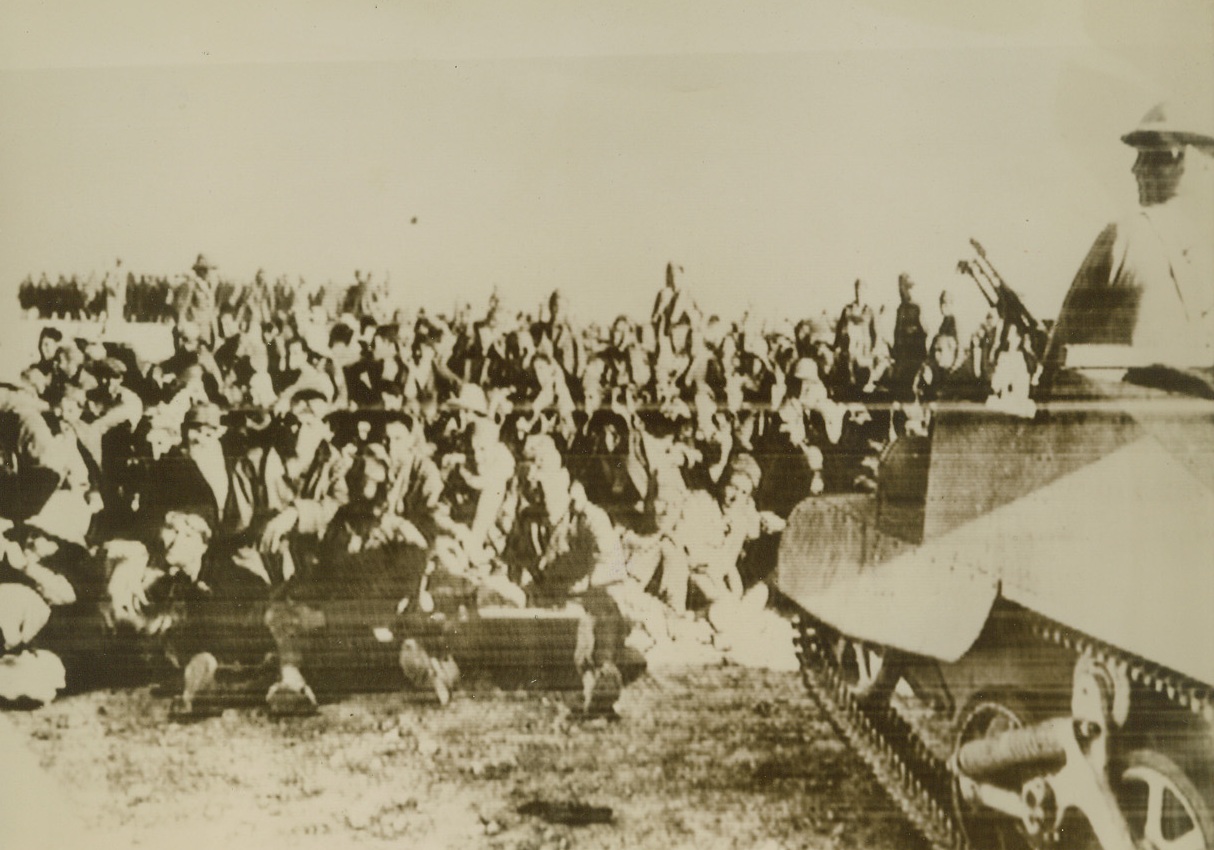
Captured Italians Await Internment, 12/29/1940 Cairo, Egypt - - Guarded by a light tank crew, scores of Italians taken prisoner by the British in the capture of Sidi Barrani sit disconsolately awaiting transportation to a prison camp where they will remain for the duration. It was reported that 30,000 prisoners were taken after a land, sea and air bombardment had subdued Italian forces occupying the desert base. Passed by British censors, this is the first photo received in this country from North Africa since the start of the English counter-offensive. Credit line (ACME Cable photo);
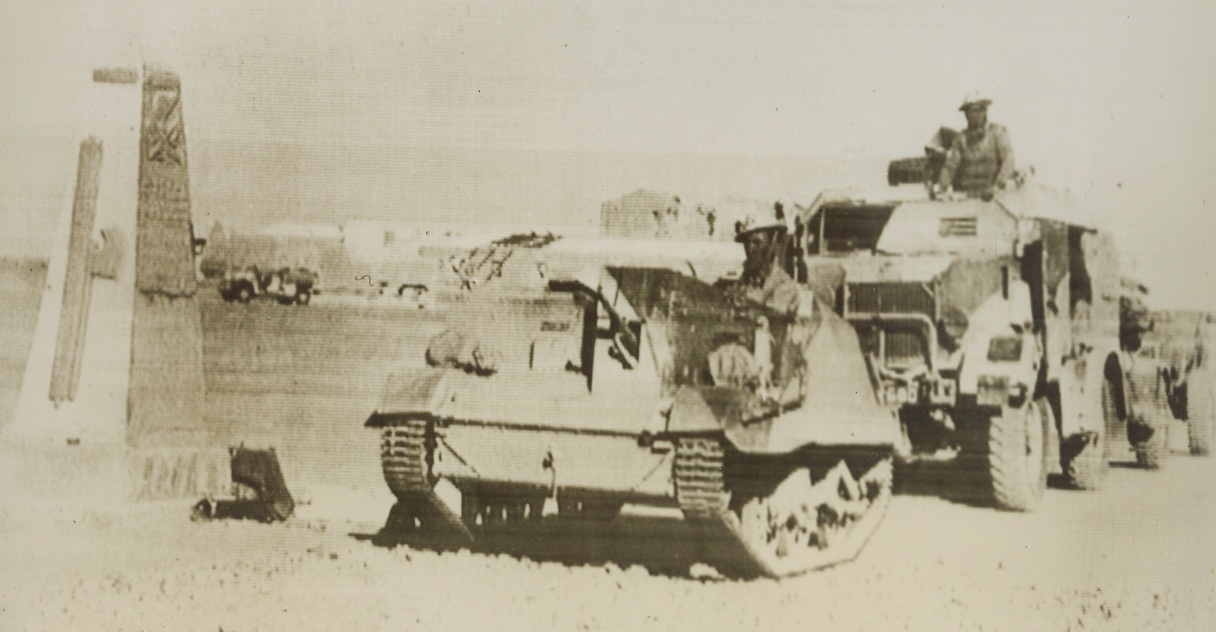
Victorious British Enter Sidi Barrani, 12/29/1940 Sidi Barrani, Egypt - - Past a stone monument erected by the Italians in celebration of their capture of Sidi Barrani, British bren gun carriers and larger armored units roll triumphantly as they retook the strategic desert town. Credit line (ACME cable photo);
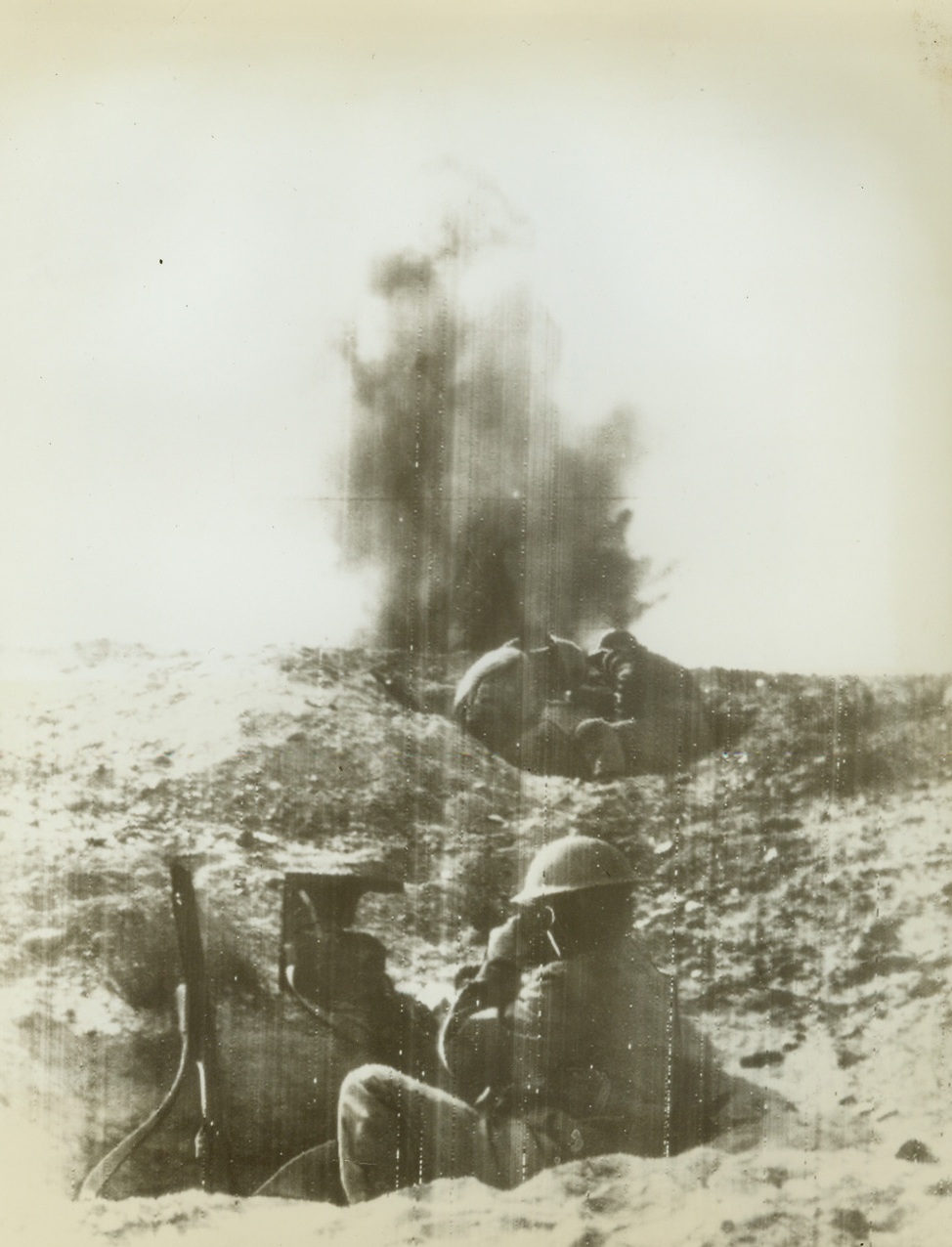
Under Fire, 12/30/1940 Somewhere in Libya—Communications men stationed at a forward observation post carry out their duties under heavy shell fire during one of Rommel’s delaying actions, fought west of Agheila, which failed so dismally. Latest reports on the British 8th Army indicate that the Allied troops have broken across the Wadi Bel-el-Chebir, the first of the remaining three possible lines of defense along the Libyan coast. Passed by censor. Credit: ACME radiophoto.;
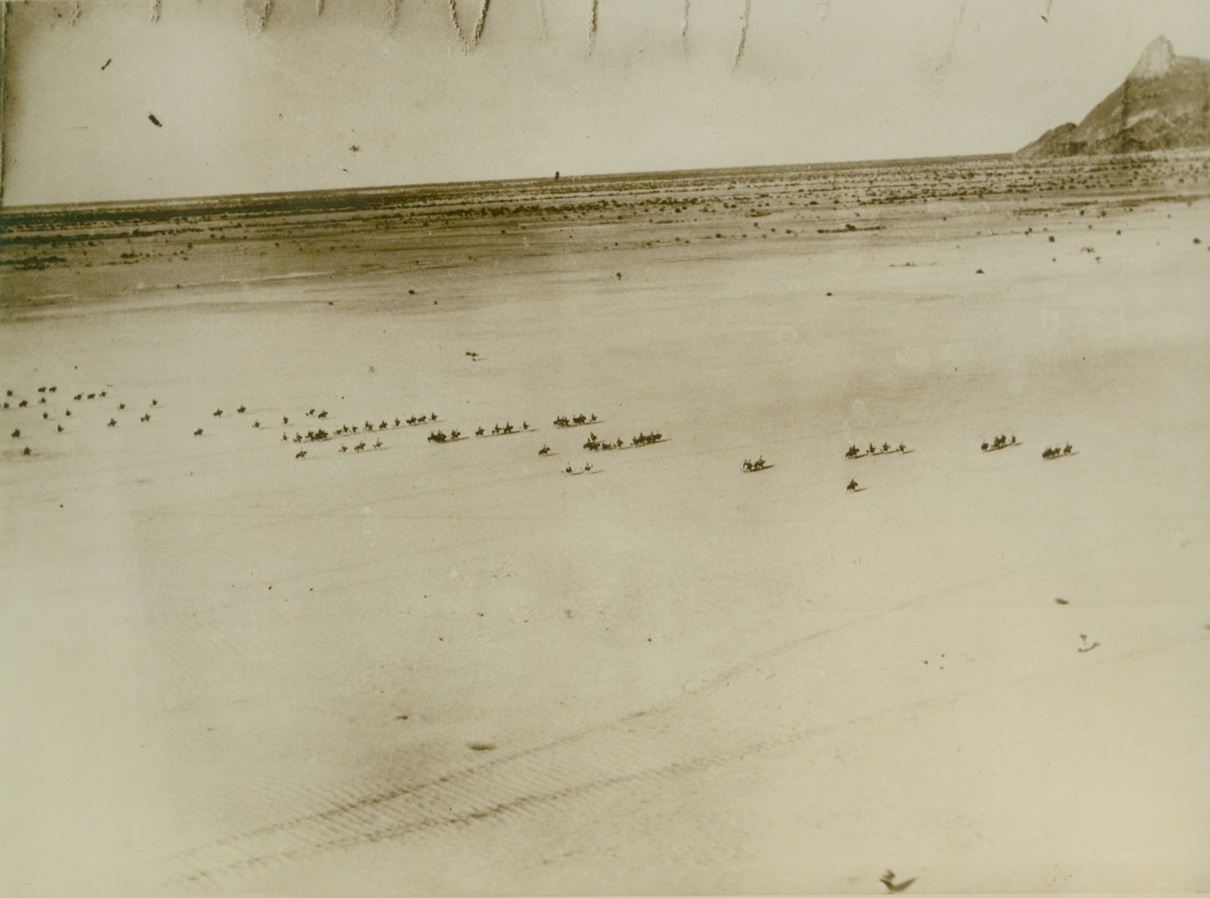
Italy Strengthens Ethiopian Defenses, 12/31/1940 ETHIOPIA – Apprehensive of a British attack in Eastern Africa since loss of territory in Egypt and Libya, Italy is rushing new forces to supplement her defenses in Ethiopia. Here according to Italian-censored caption, cavalry units in the region of Kassala (Anglo-Egyptian Sudan) advance across the desert, guarded overhead to war planes. In the sand may be seen track of motorized units preceding them. Credit: (ACME);
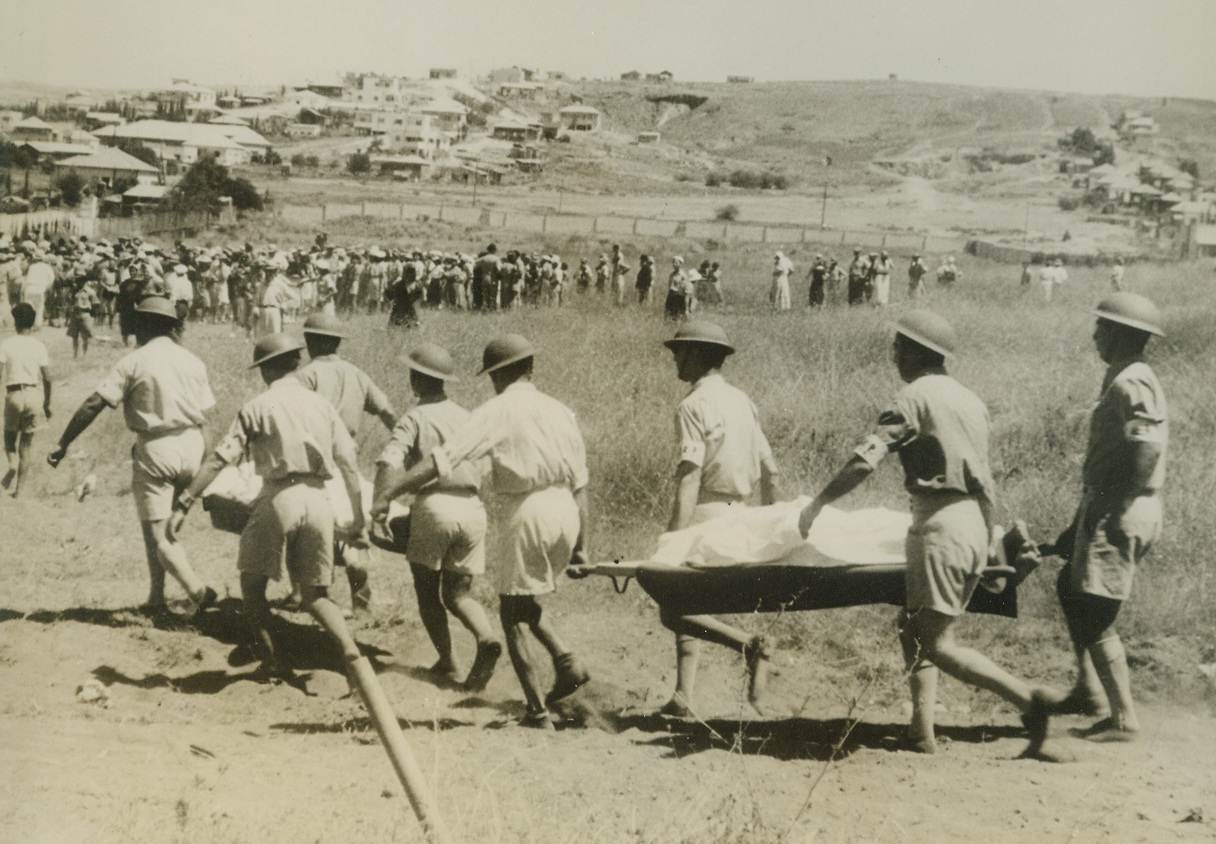
Tel Aviv Buries Air Raid Dead, 12/31/1940 Tel Aviv, Palestine.. – Members of the Tel Aviv Civil Guards carry the bodies of those killed during the Italian raid on the city to the cemetery here. These photos, made some time ago are the first pictures reaching here following the disastrous bombardment of the Palestine capital. Credit line (ACME);
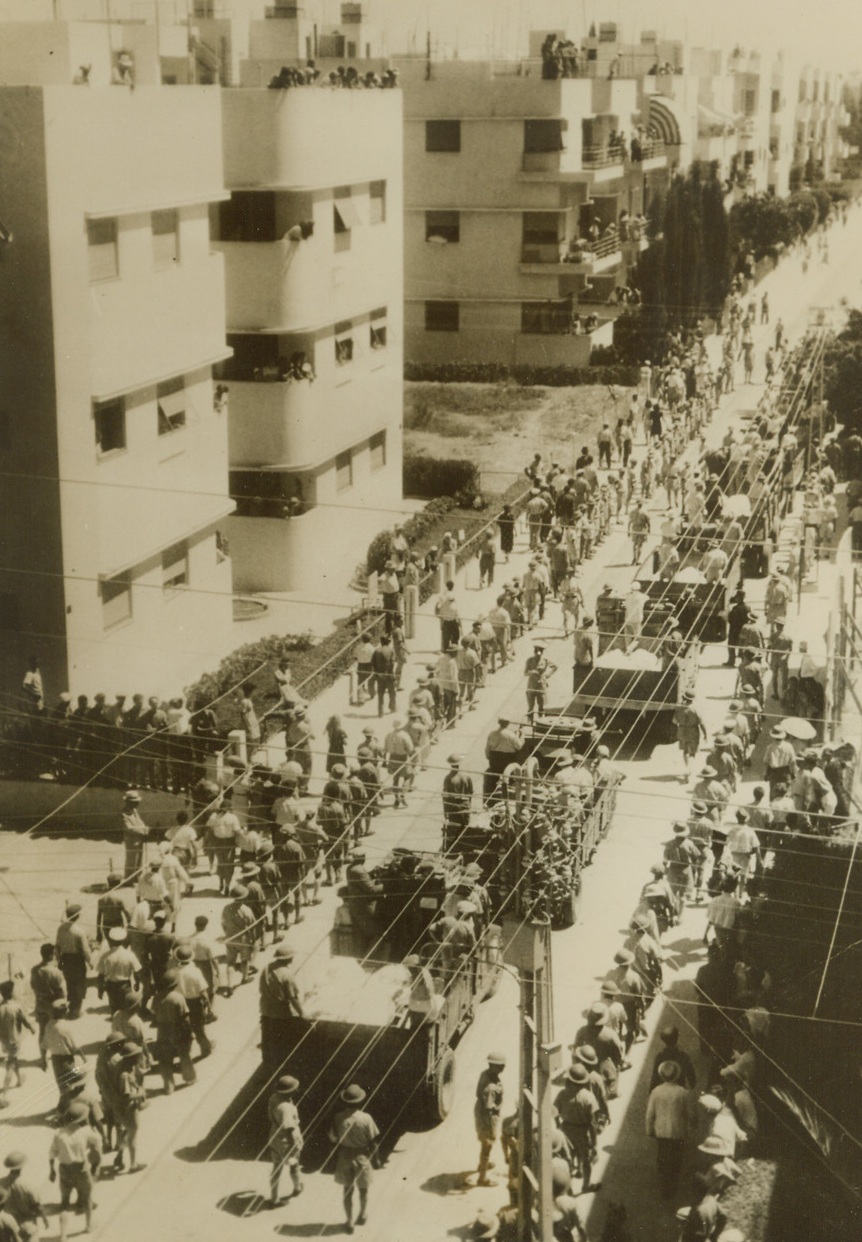
Tel Aviv Buries Air Raid Dead, 12/31/1940 Tel Aviv, Palestine - - Trucks carry the bodies of the victims of the Italian raid on this city through the streets to the cemetery where all were buried in a common grave. A number were killed in the raid. This is one of the first photos arriving here since the raid, which occurred some time ago. Credit line (ACME);





 Trash & Recycling
Trash & Recycling
 Online Payments
Online Payments
 City Documents
City Documents
 Parks
Parks
 Traffic Court
Traffic Court
 CITY PARKS
CITY PARKS
 Outdoor Recreation
Outdoor Recreation
 Volunteer
Volunteer
 Home
Home TRANSLATE
TRANSLATE
